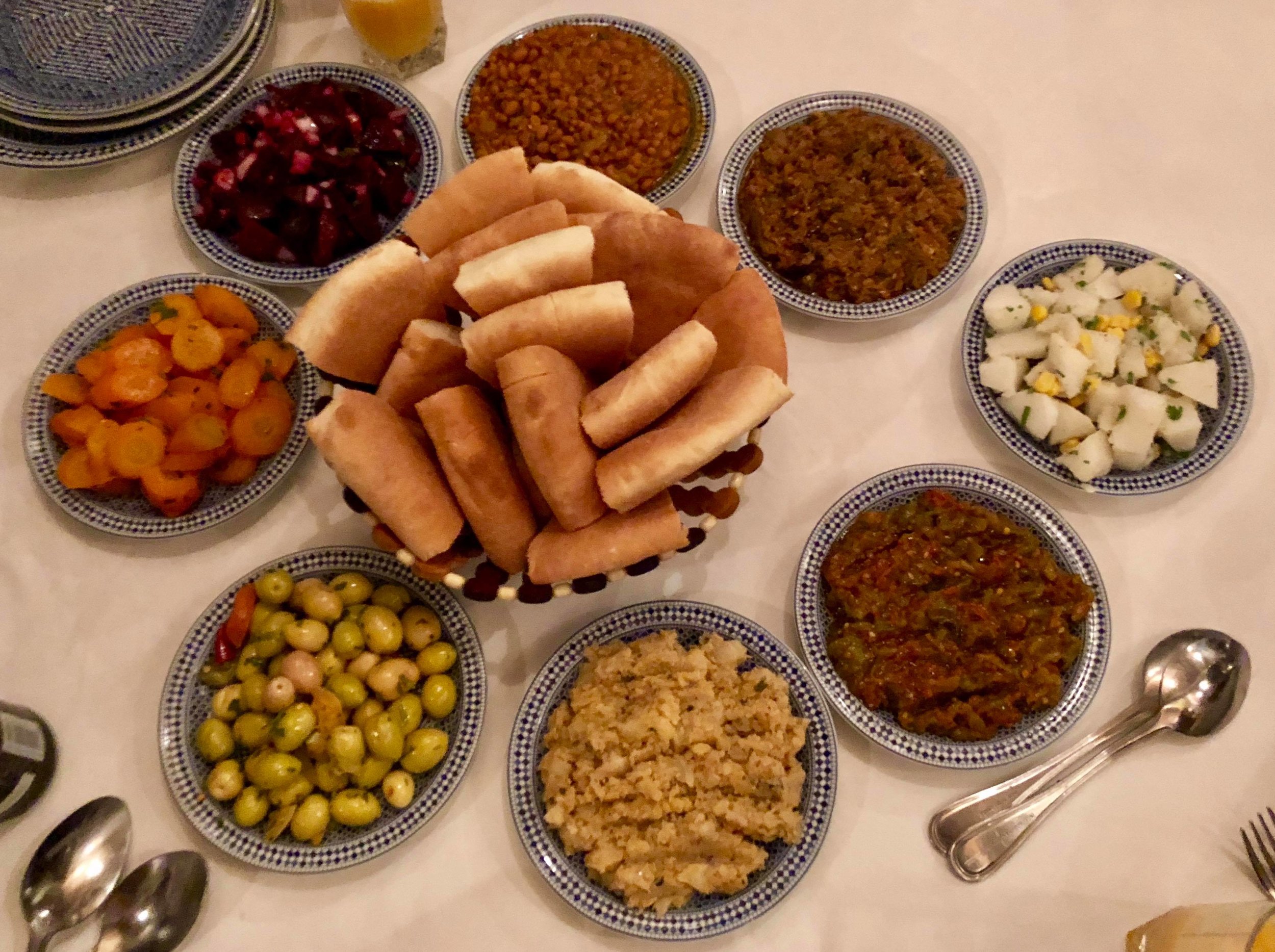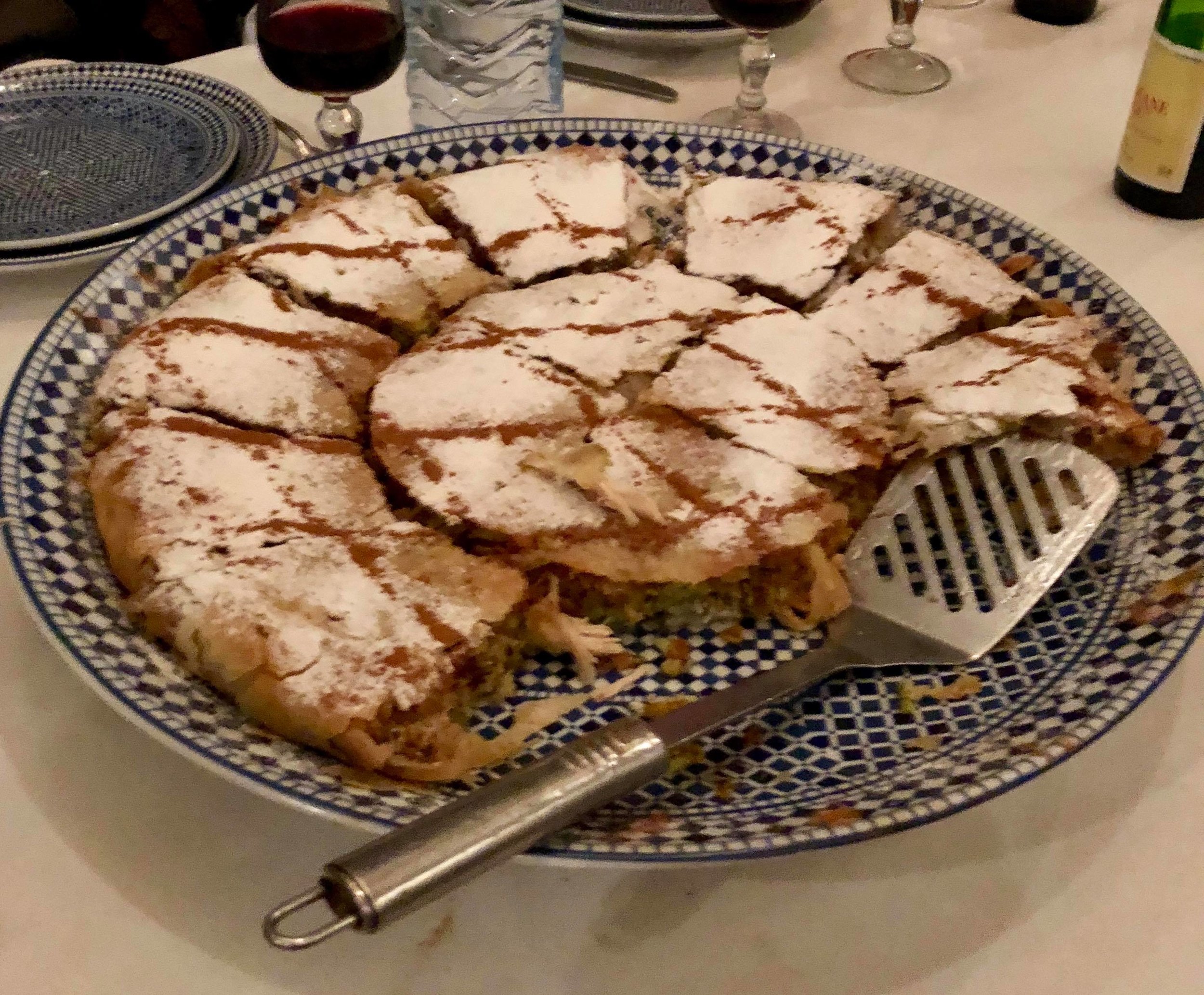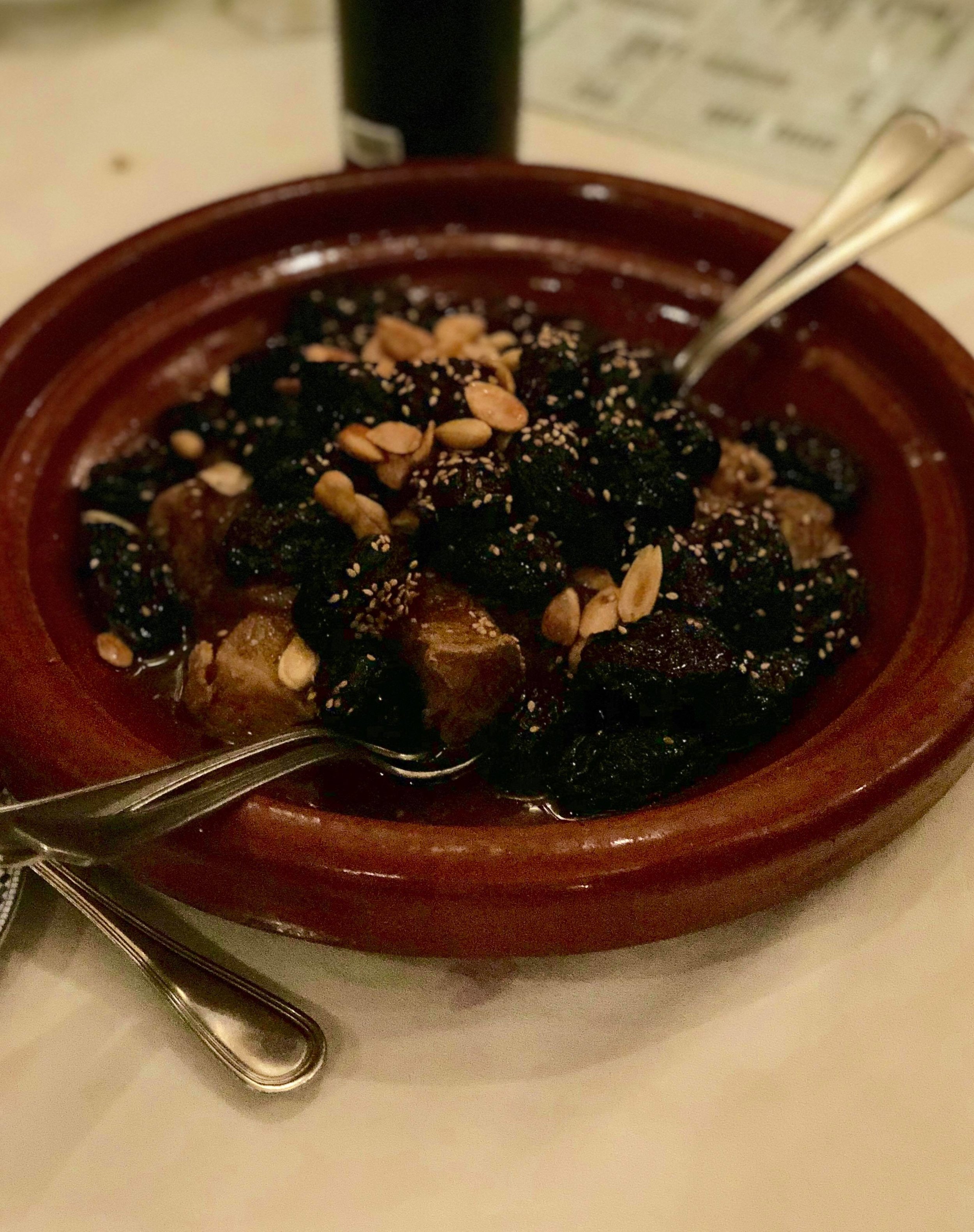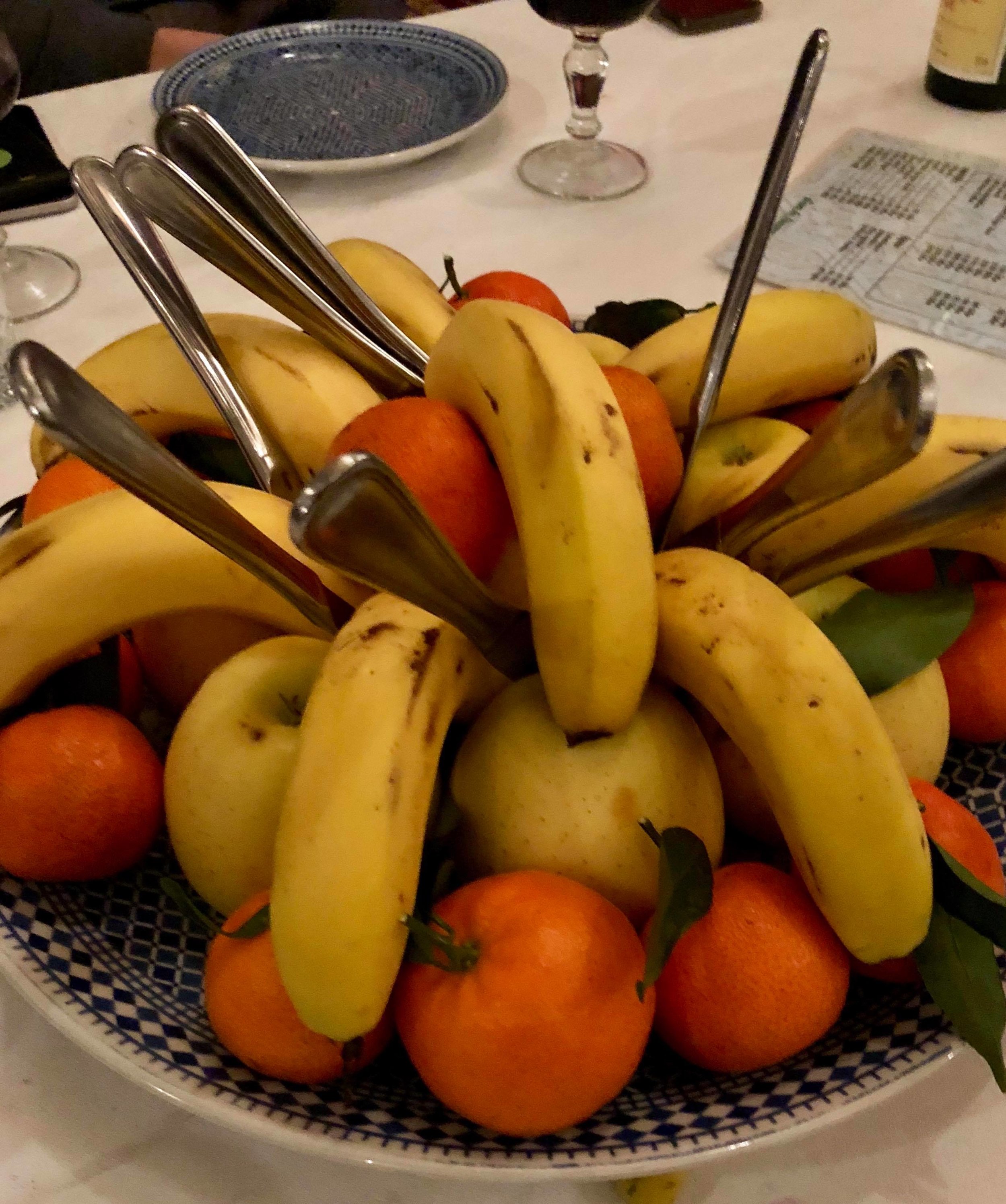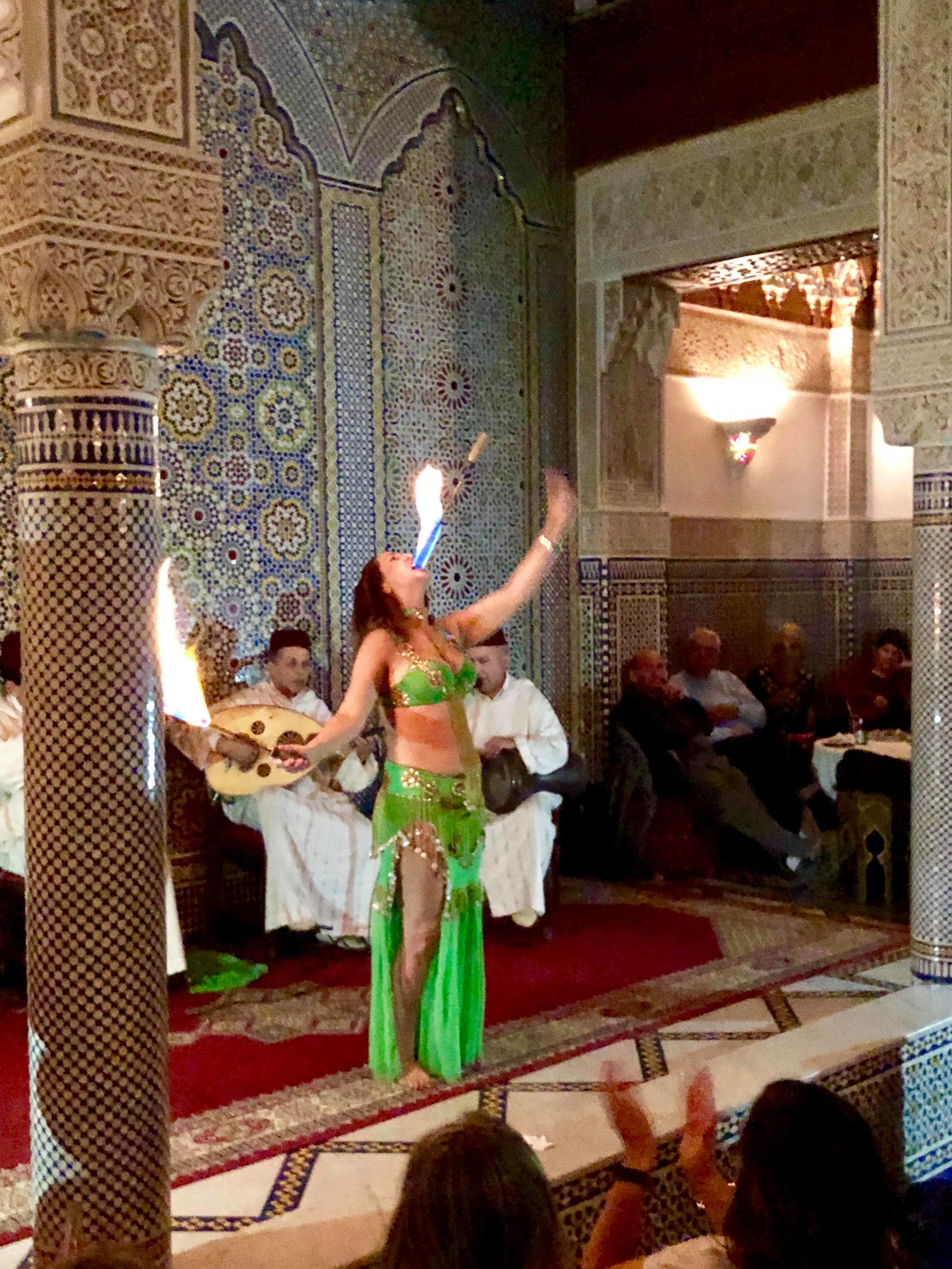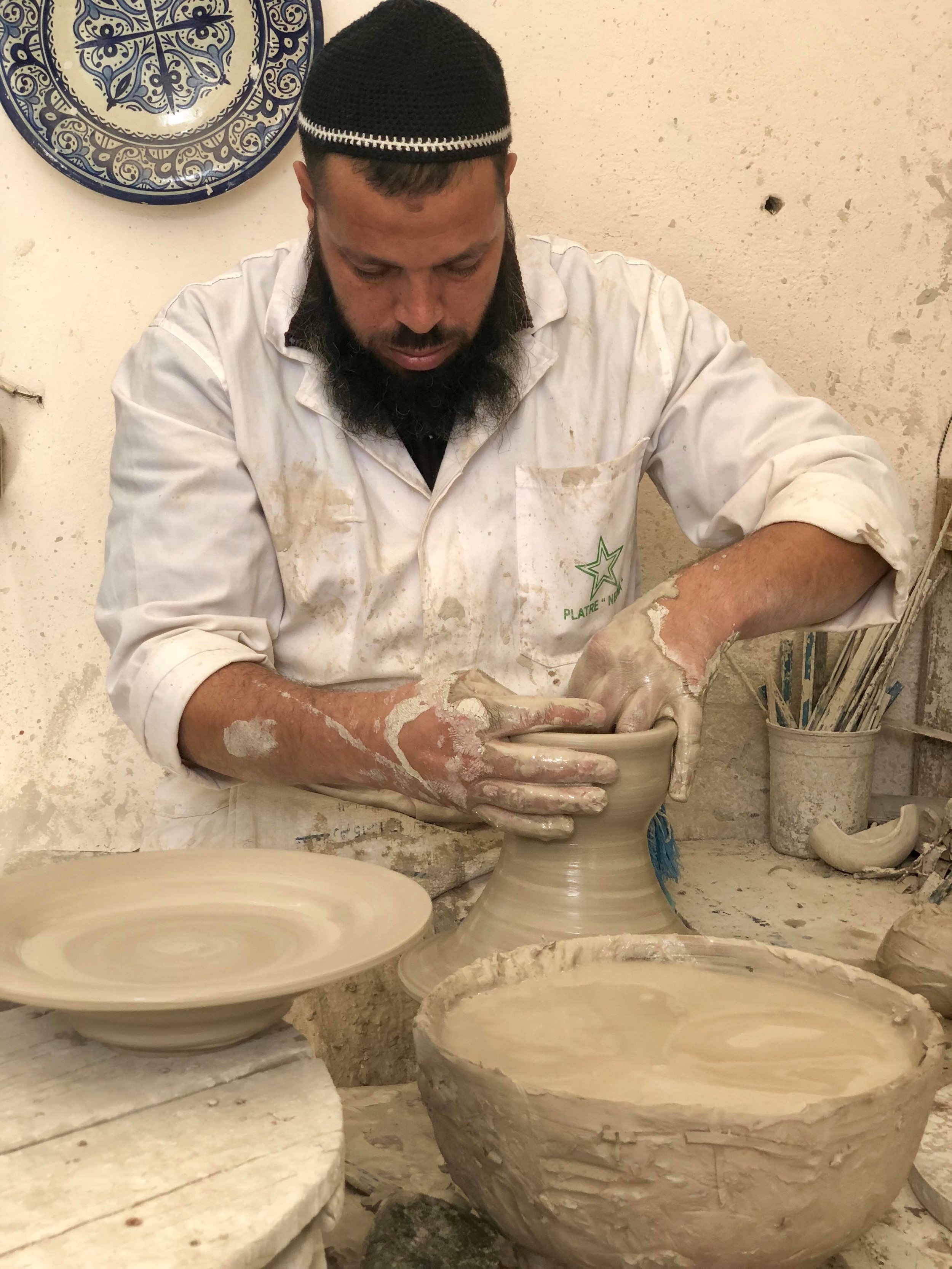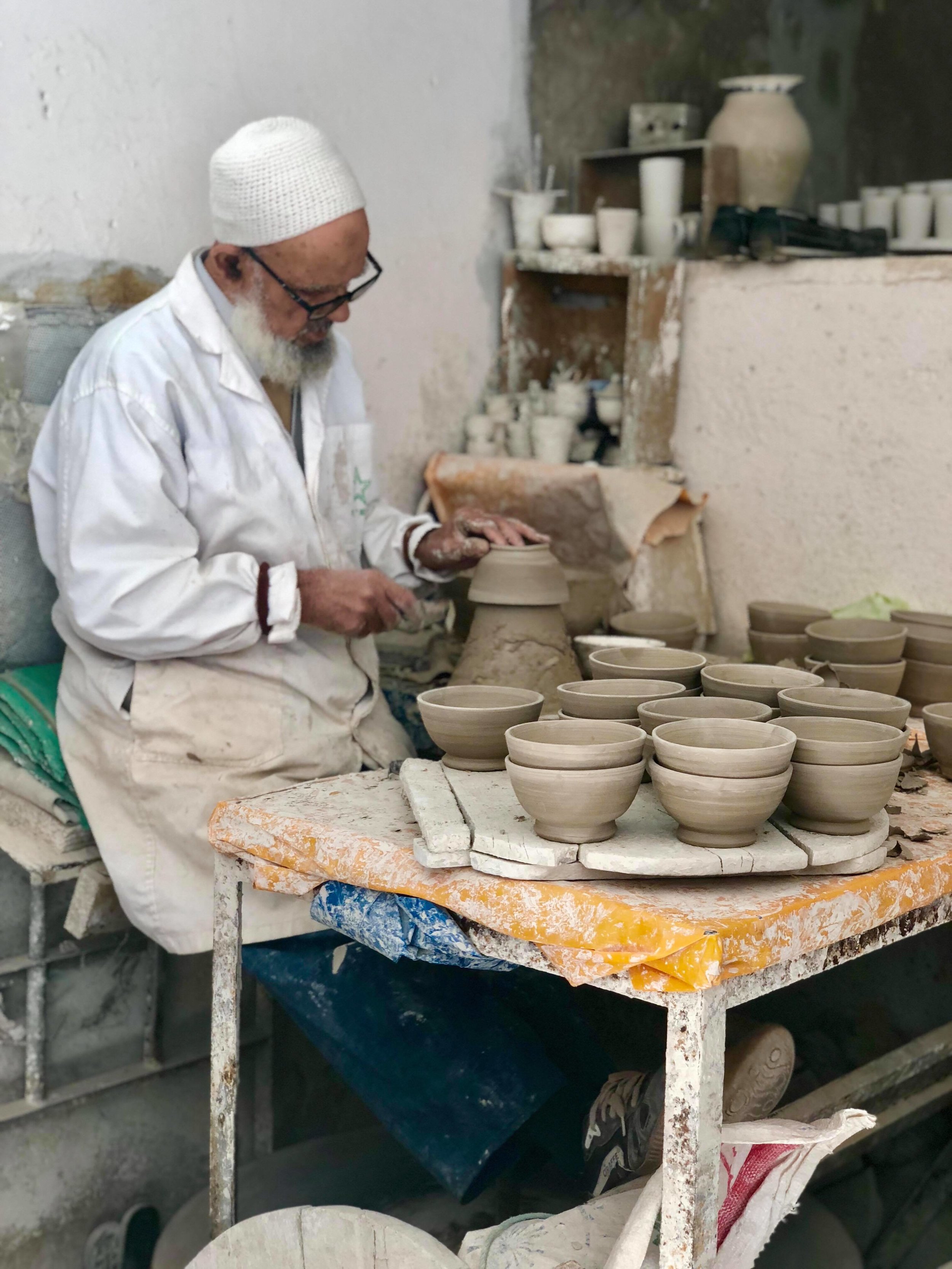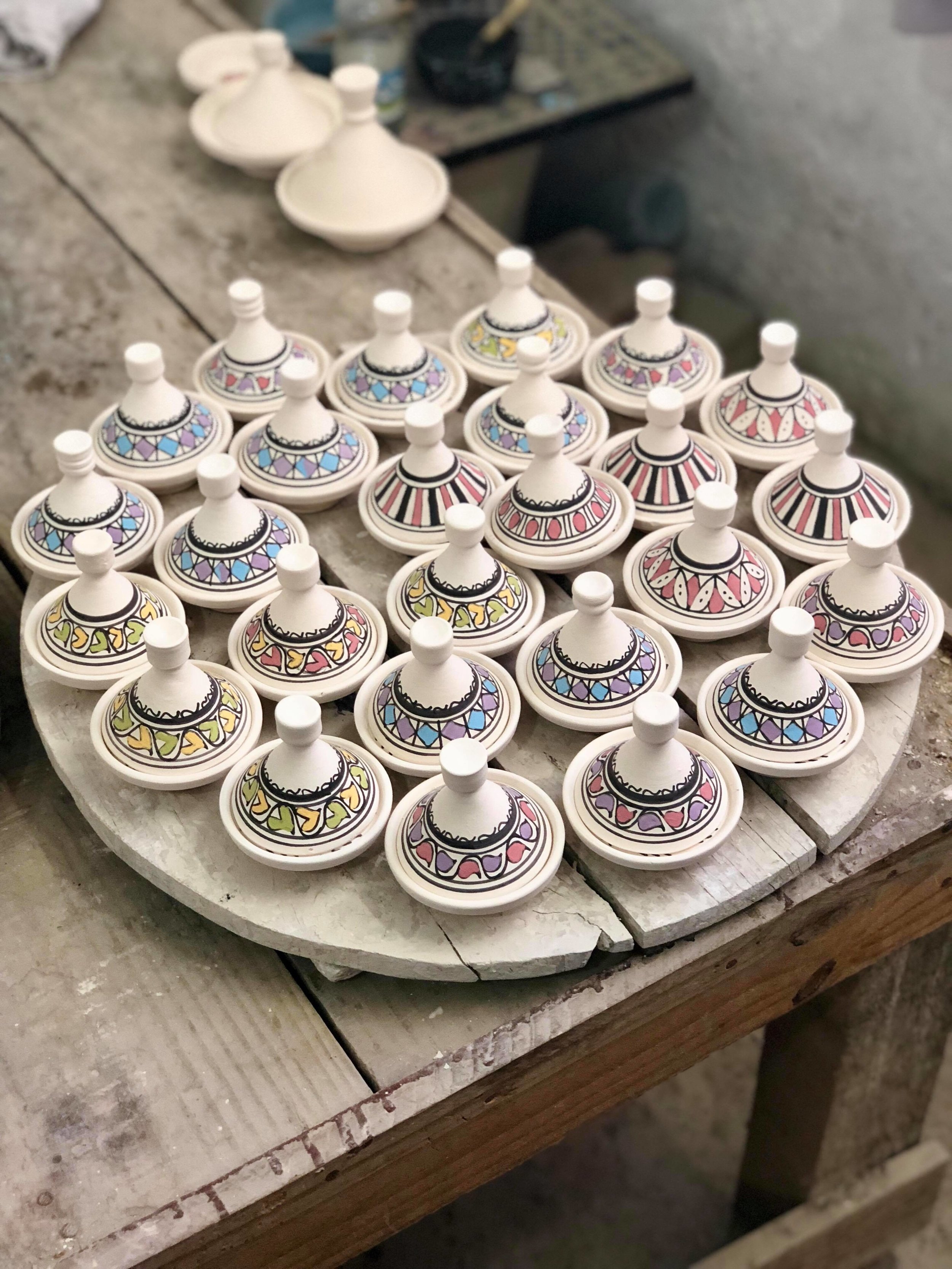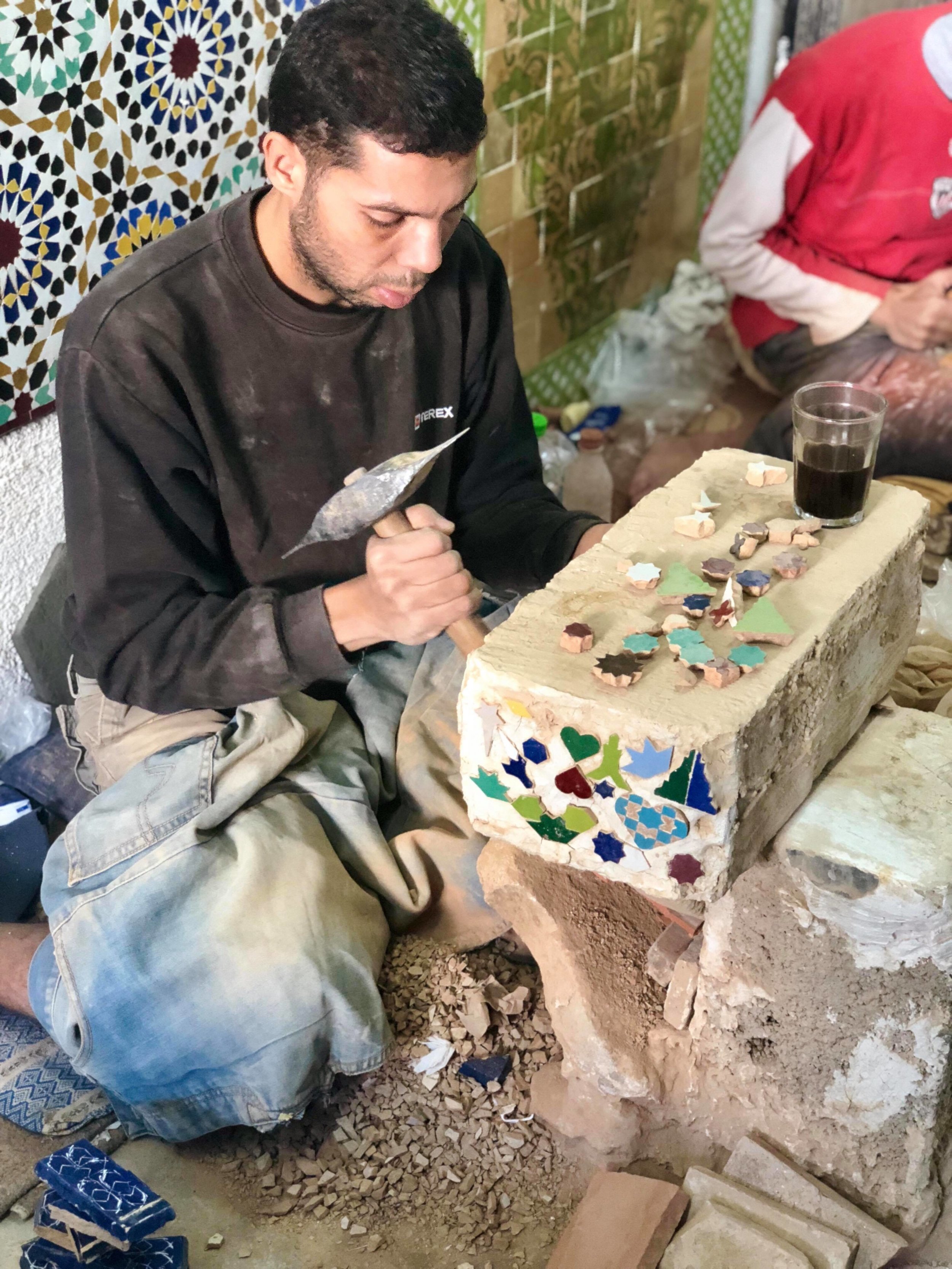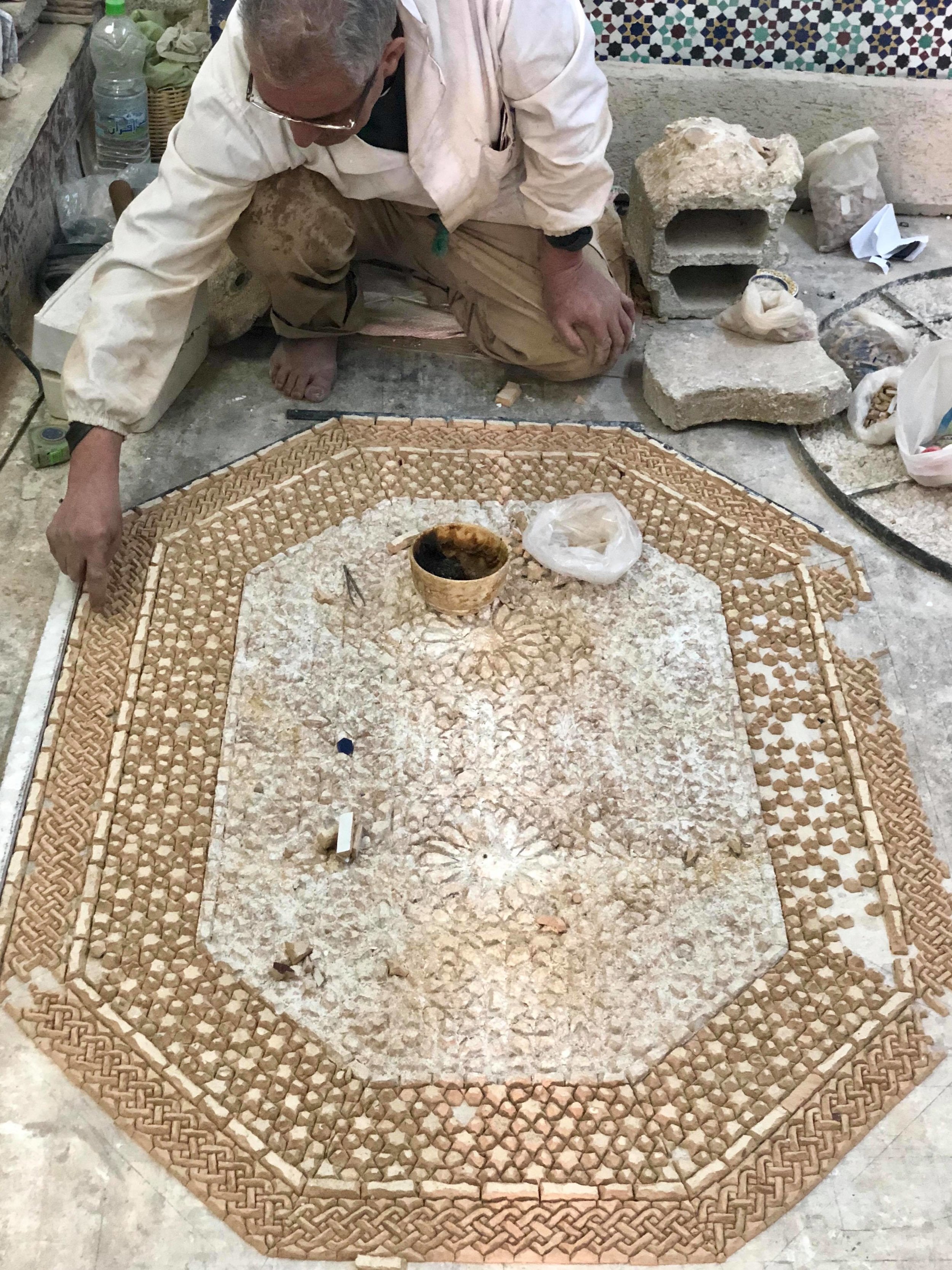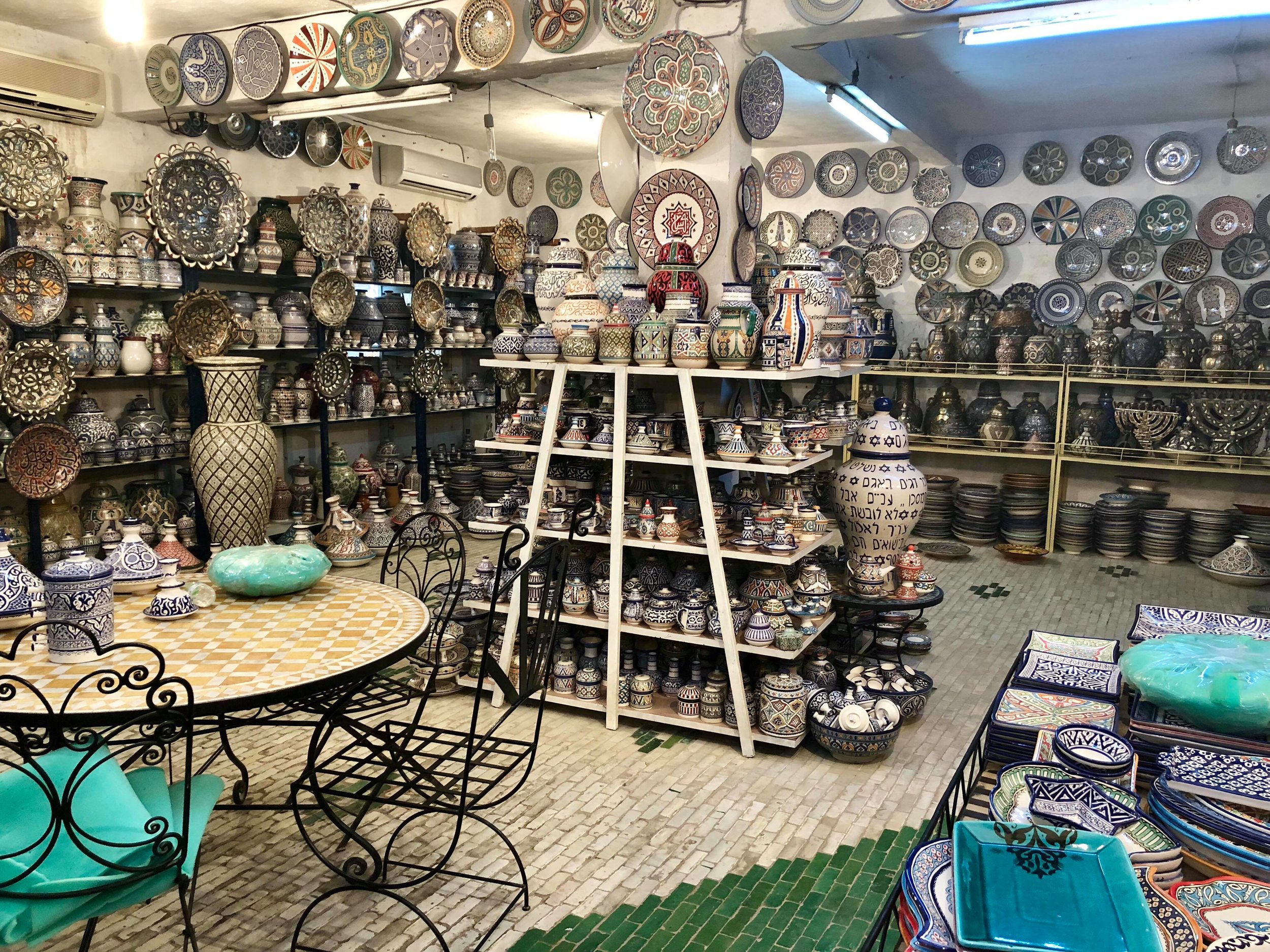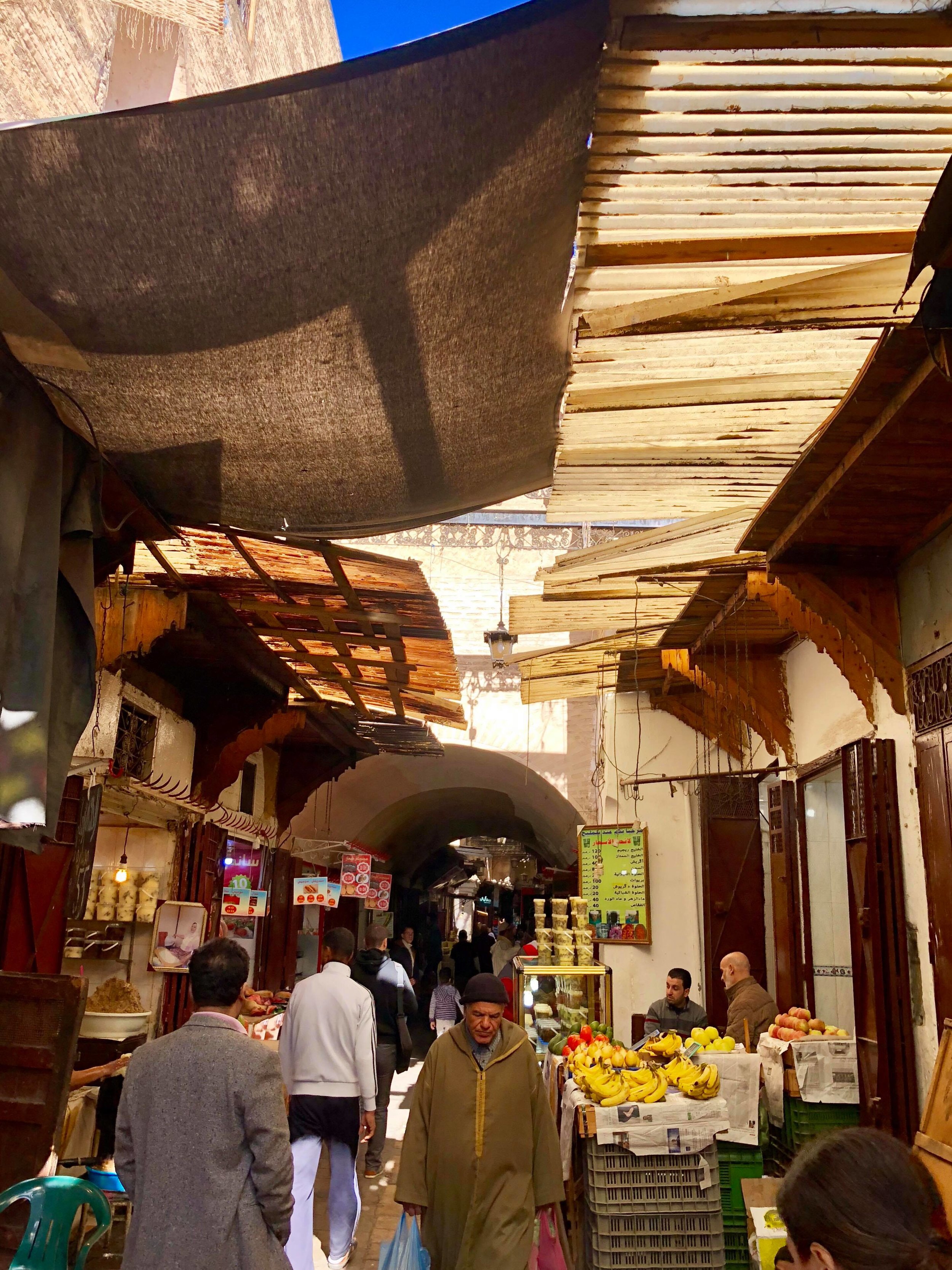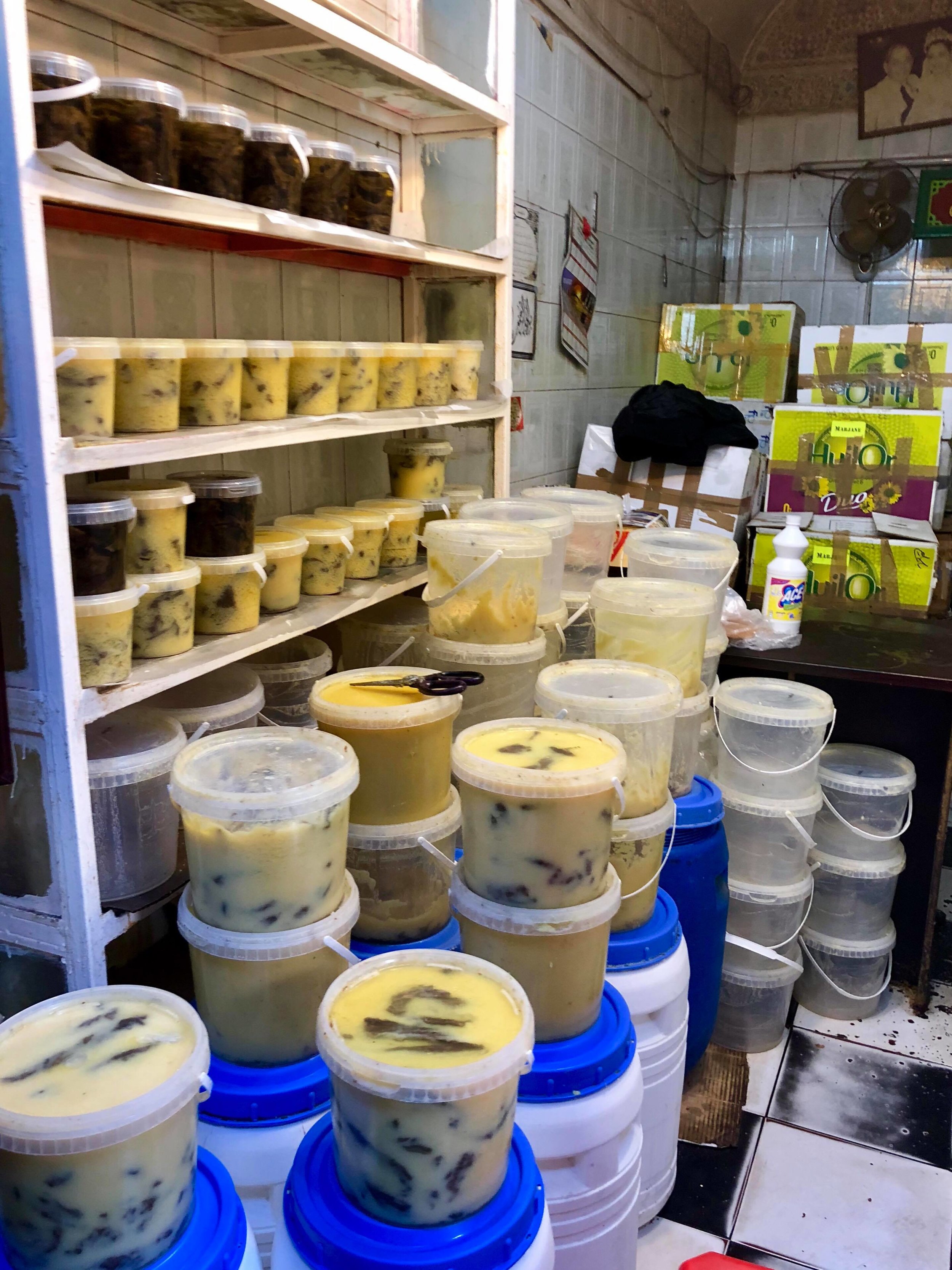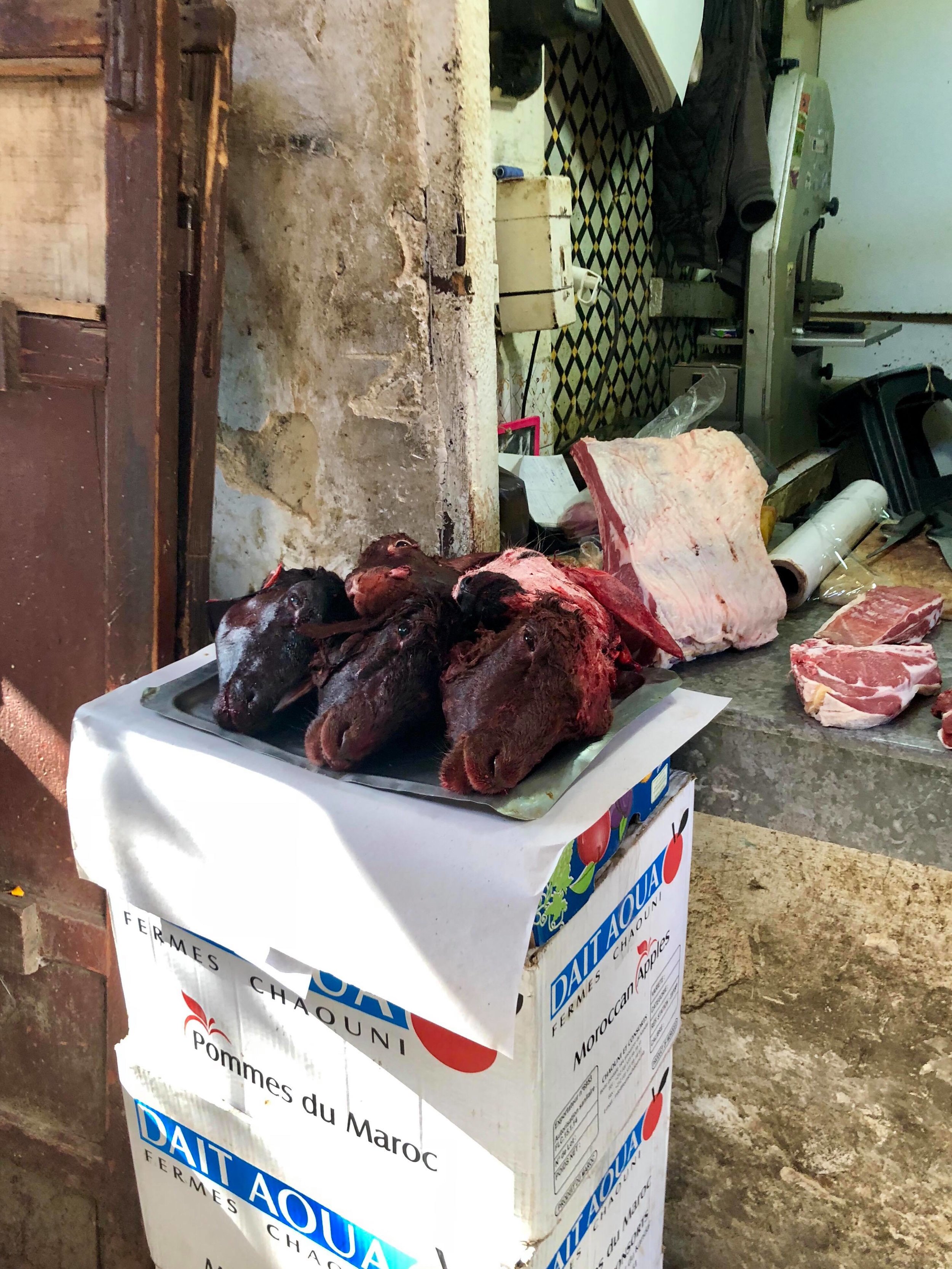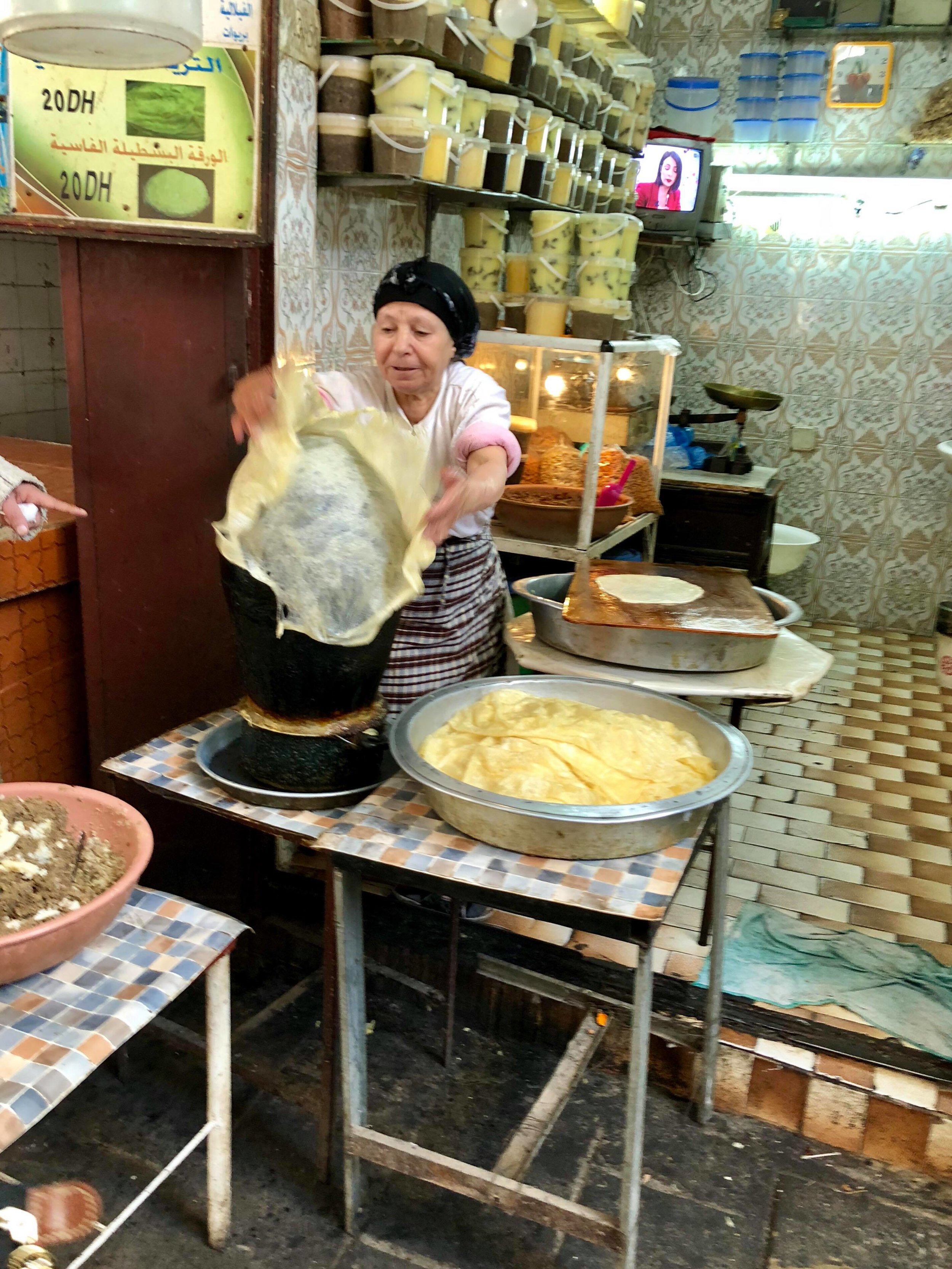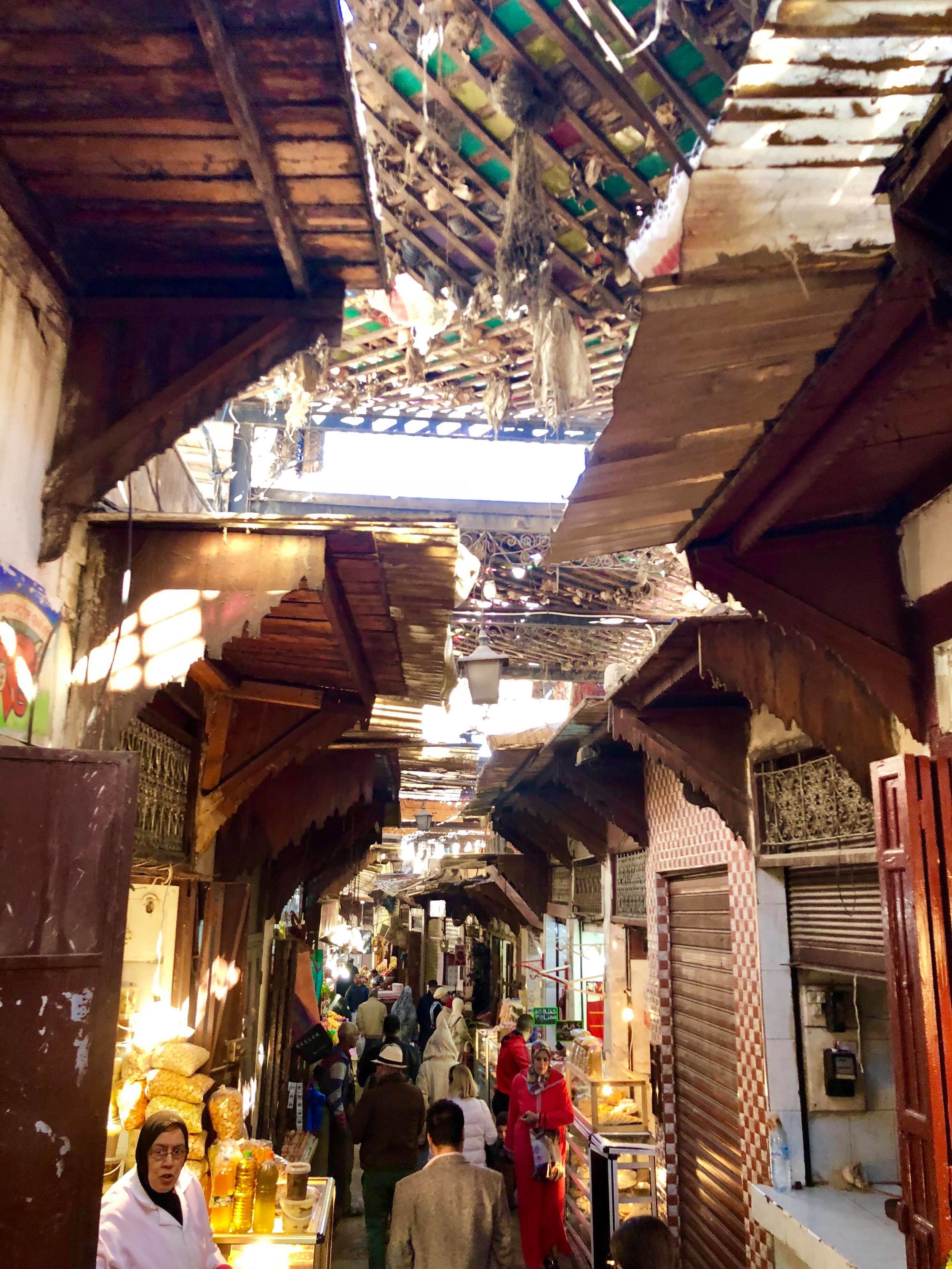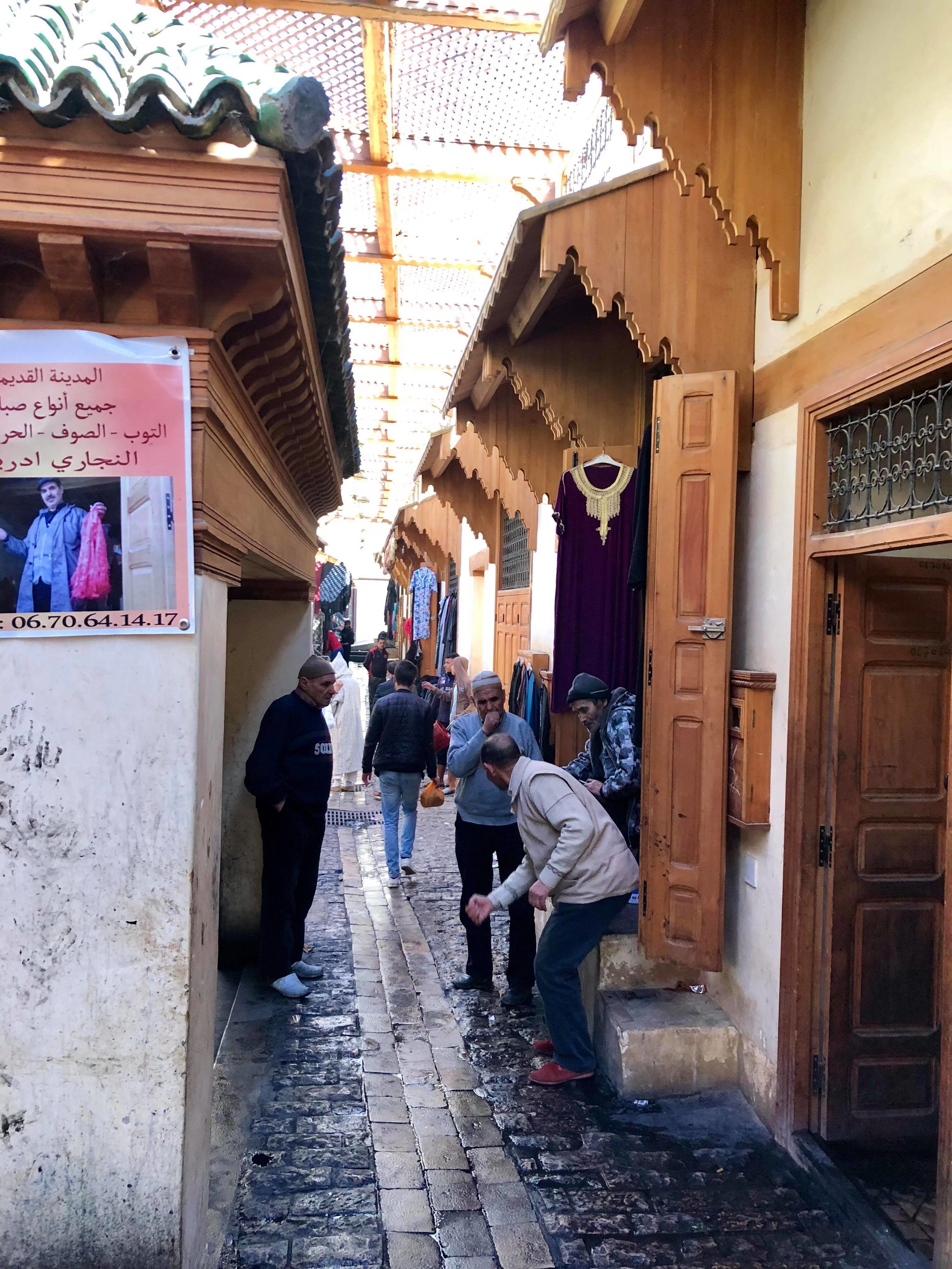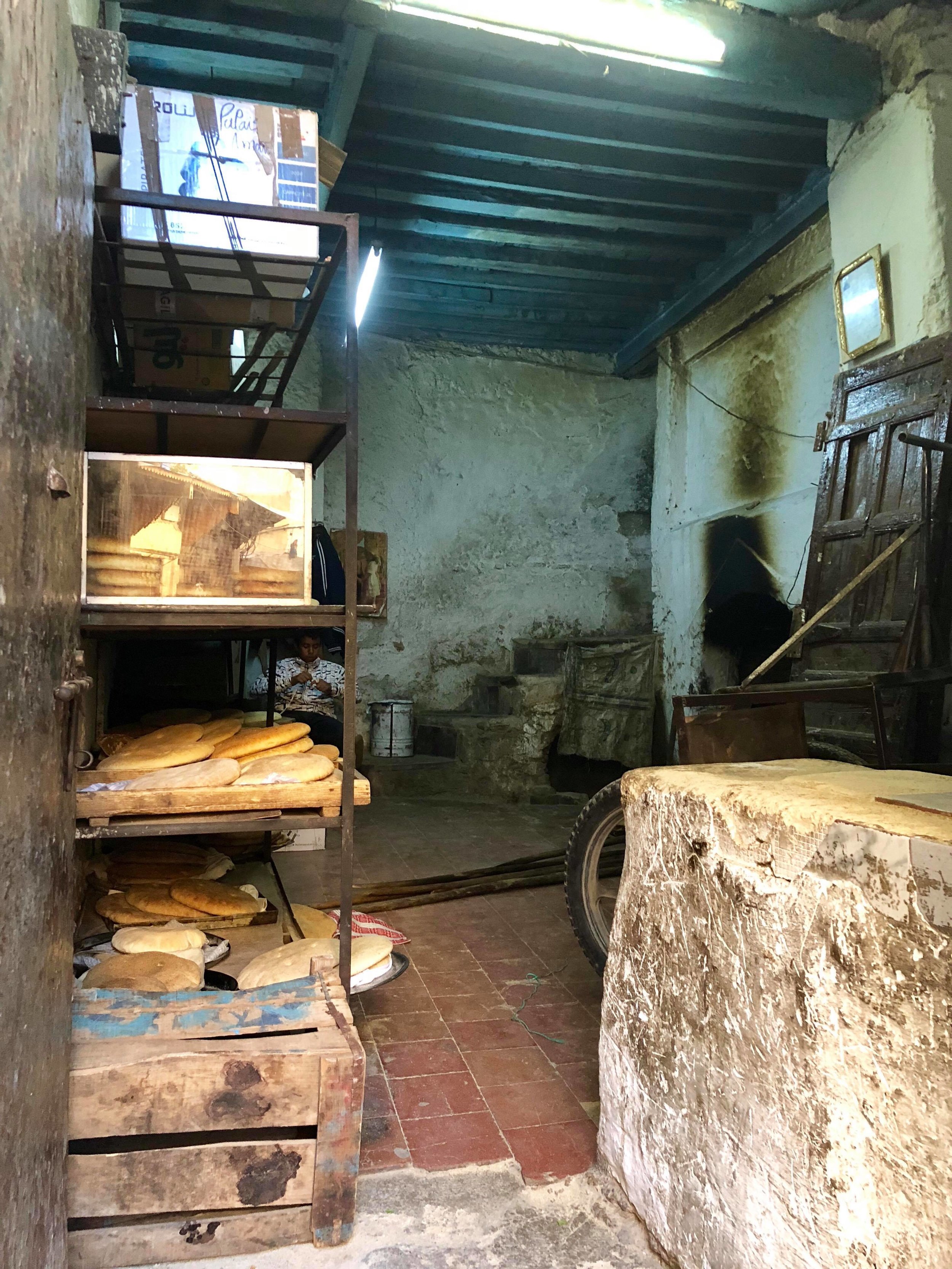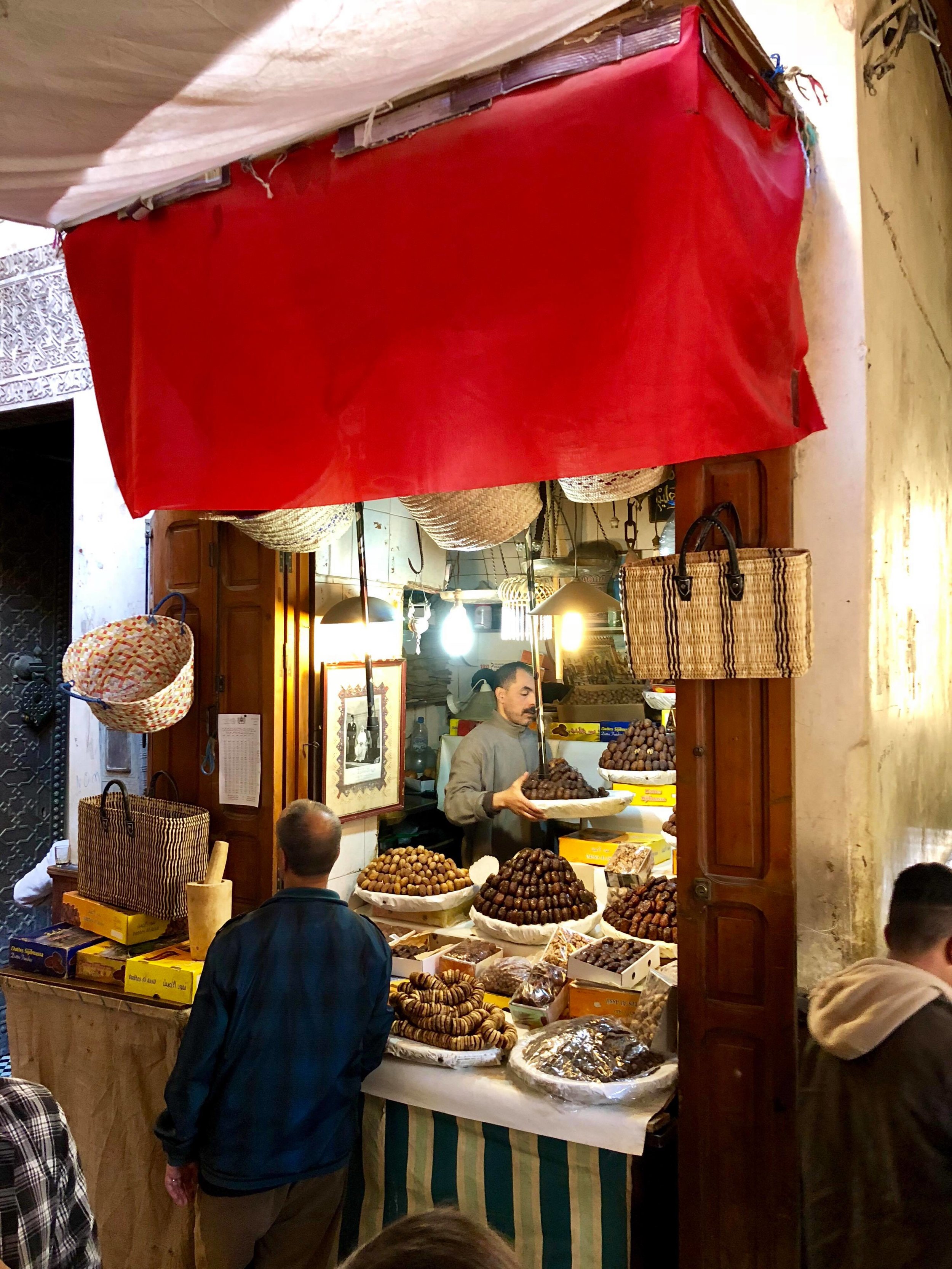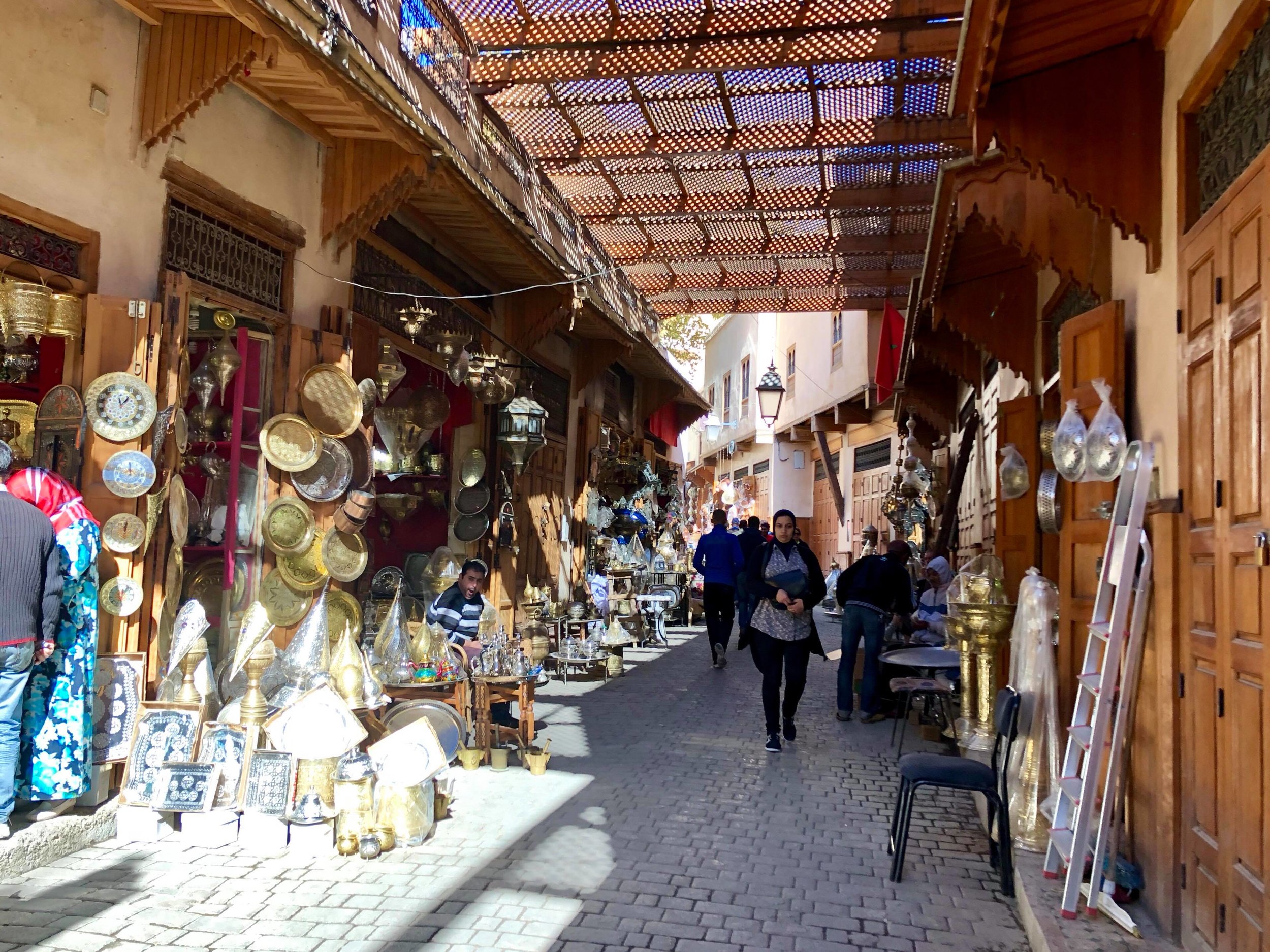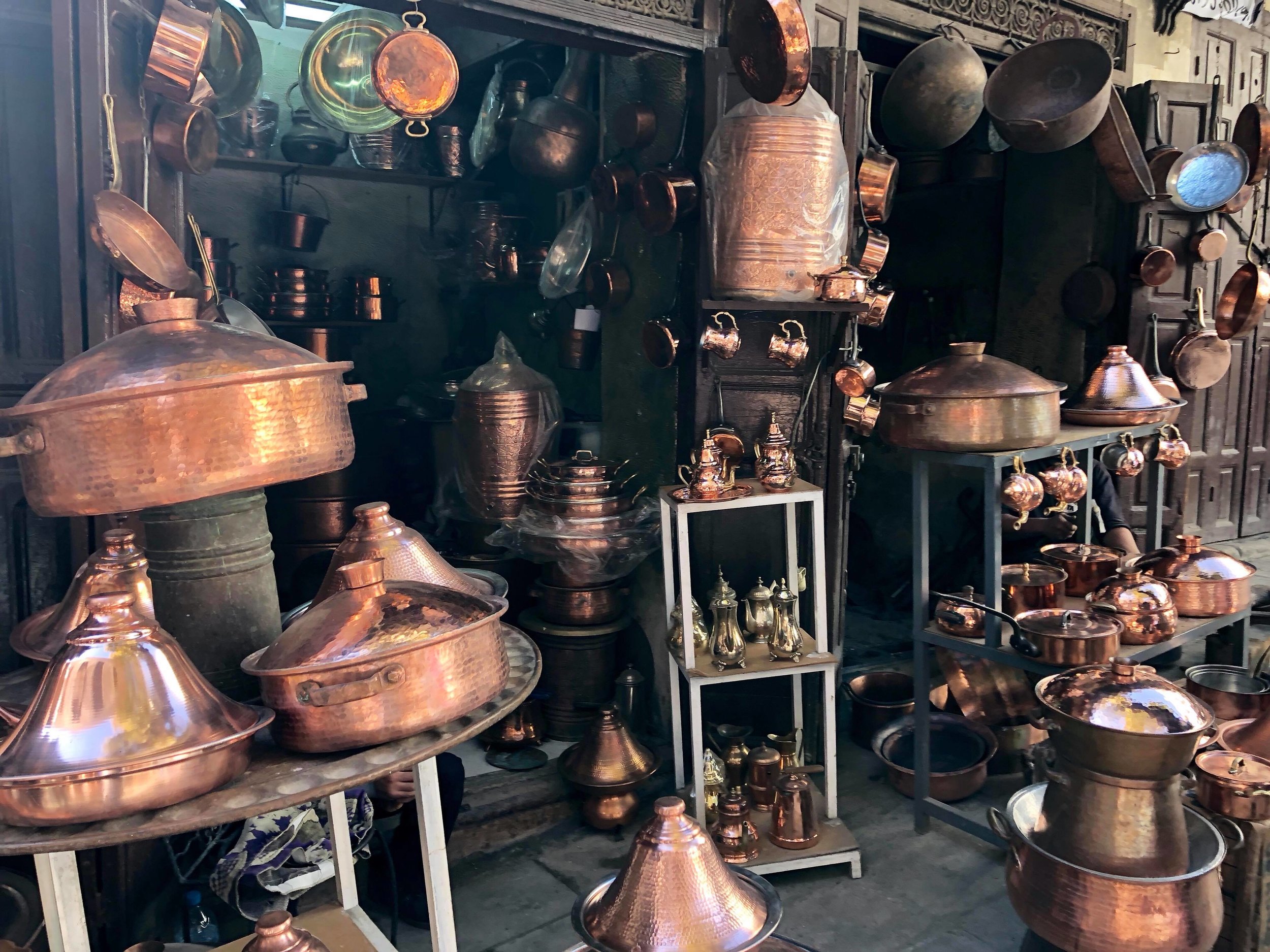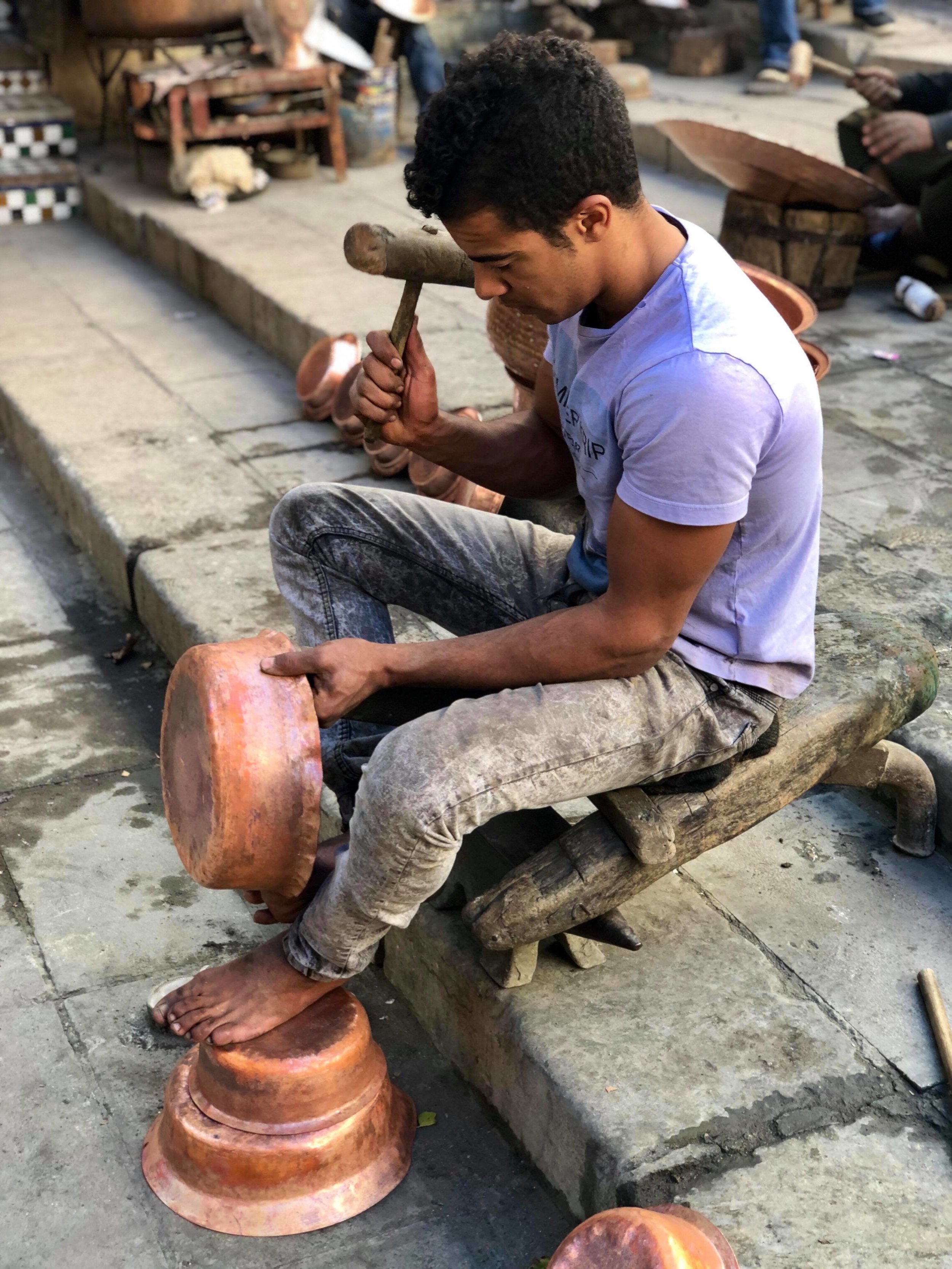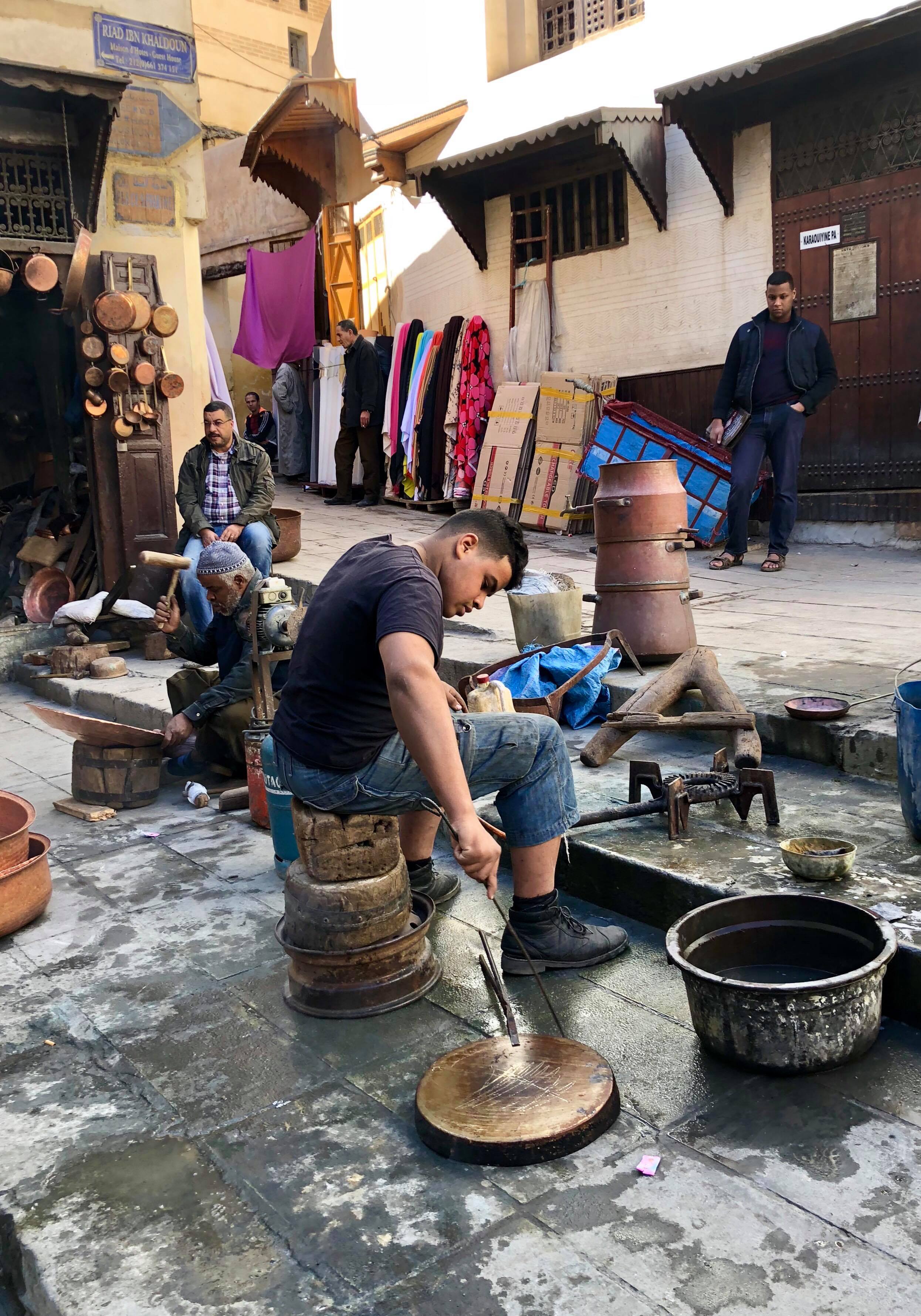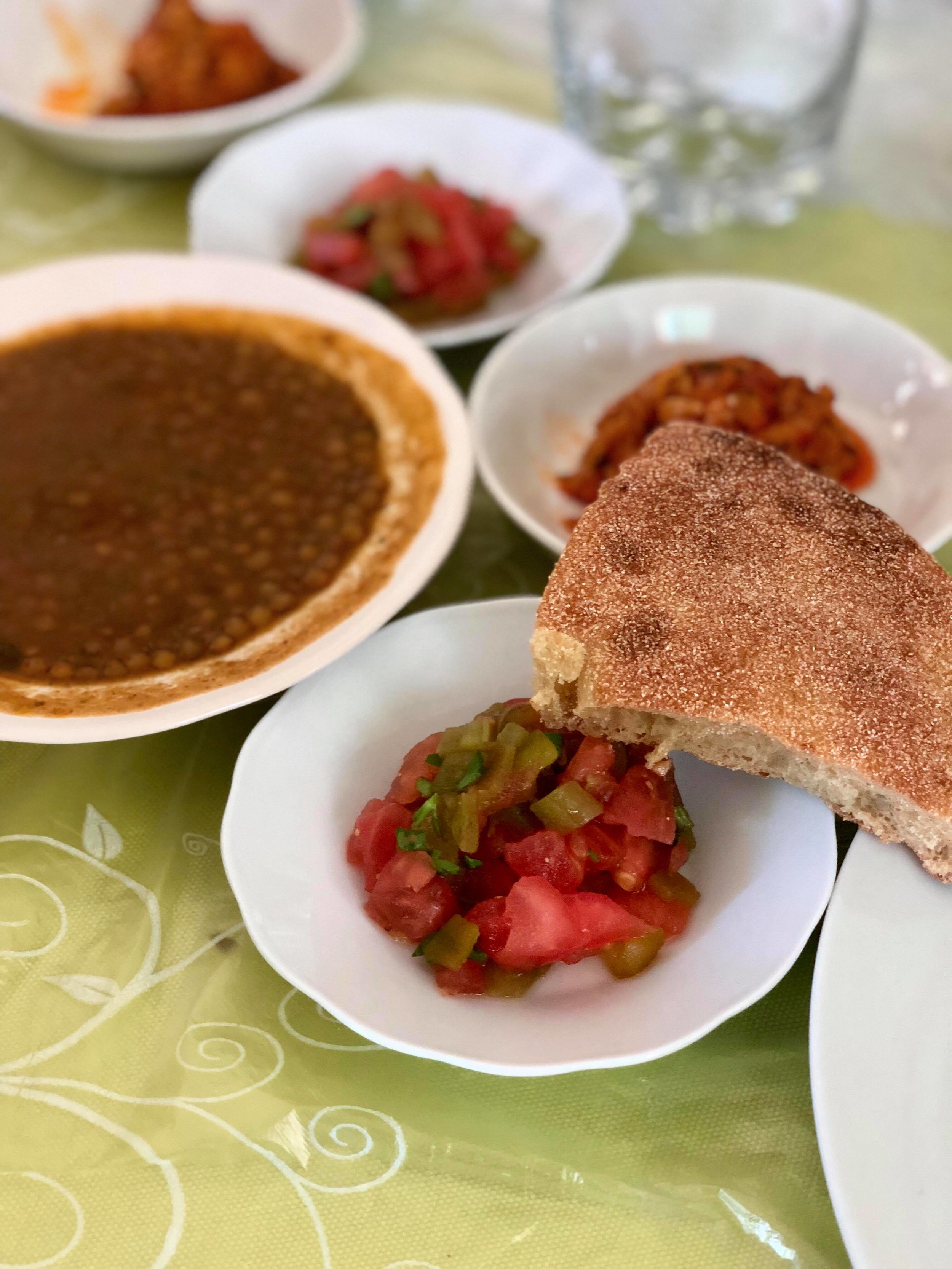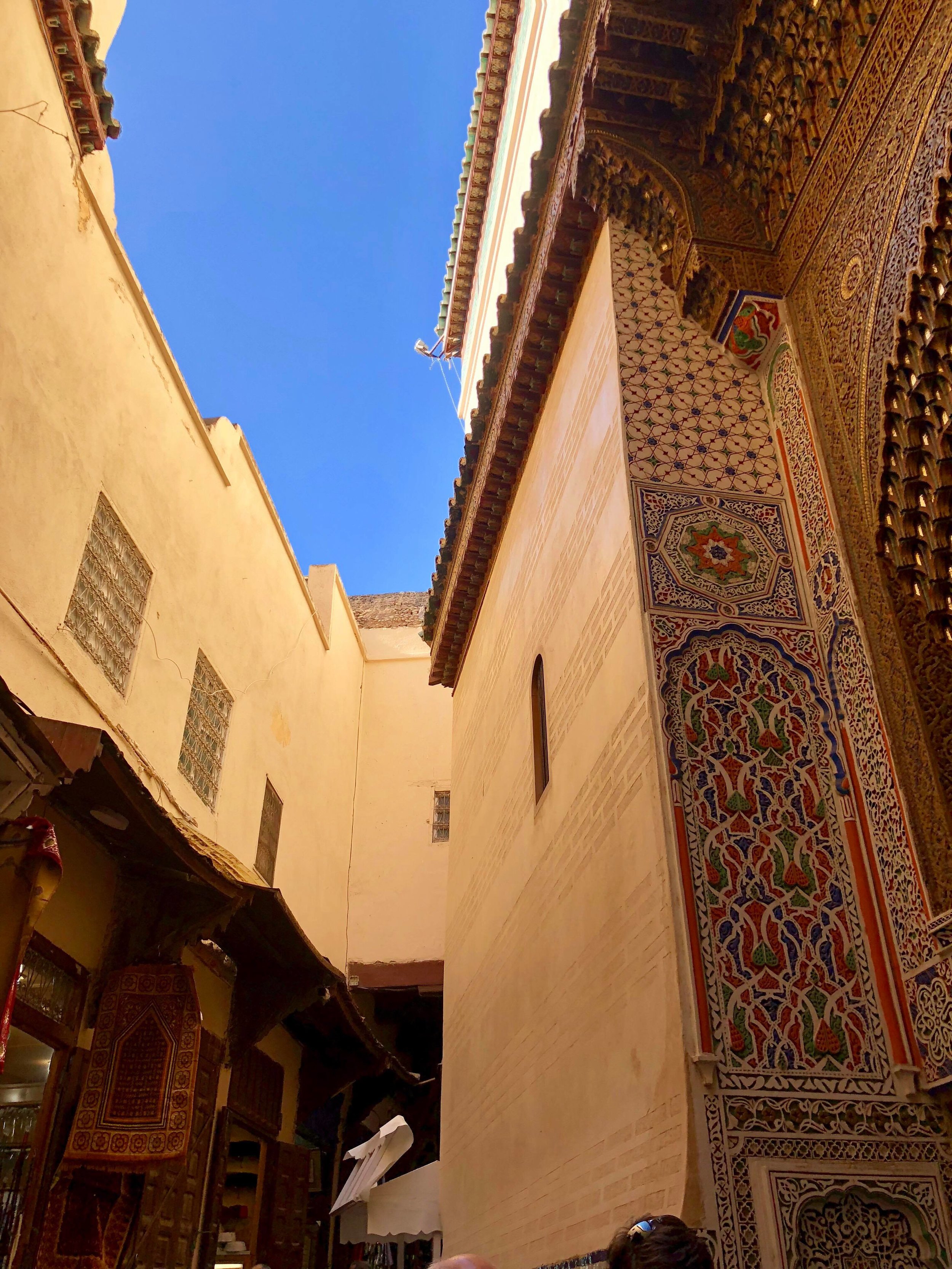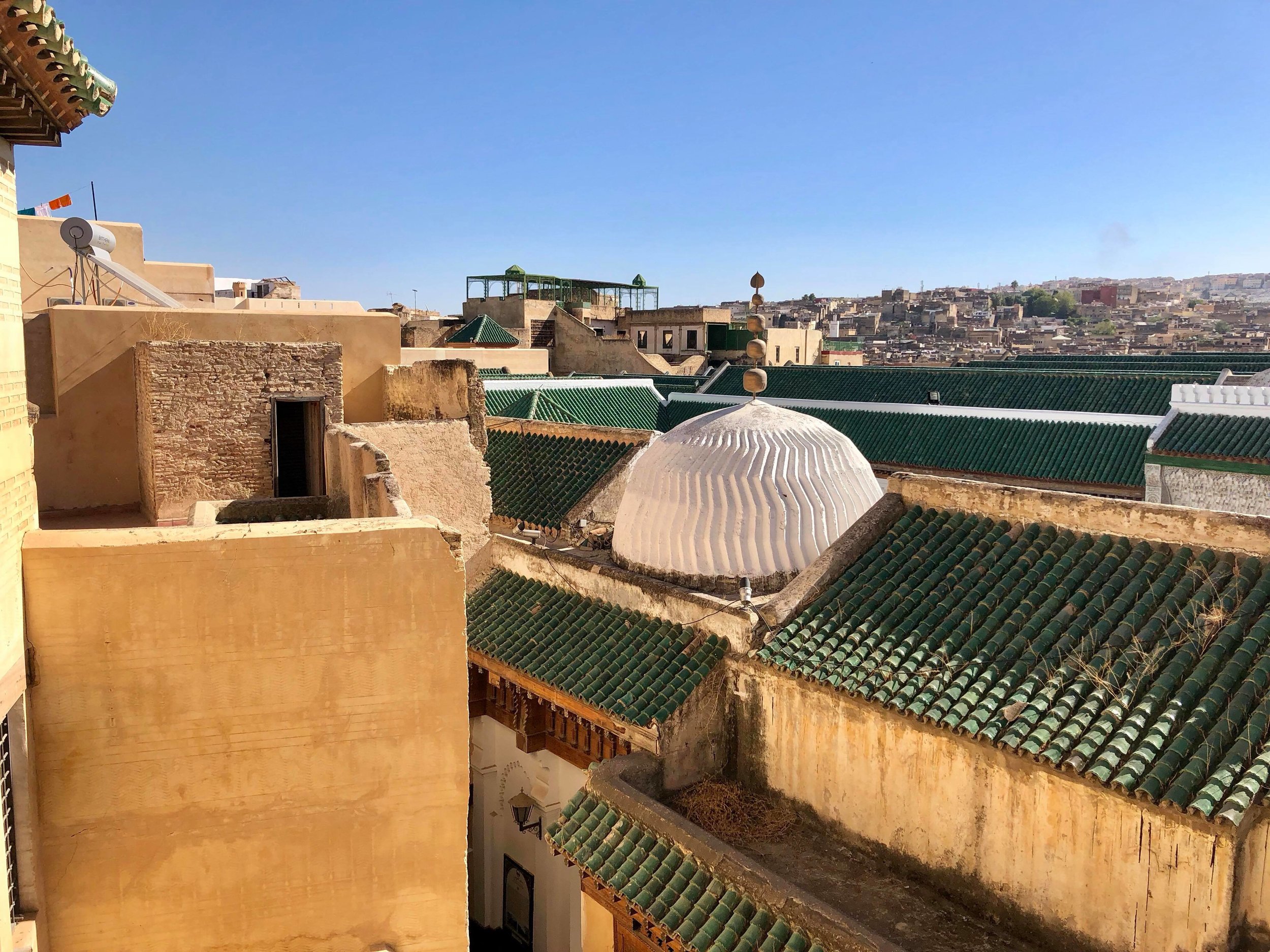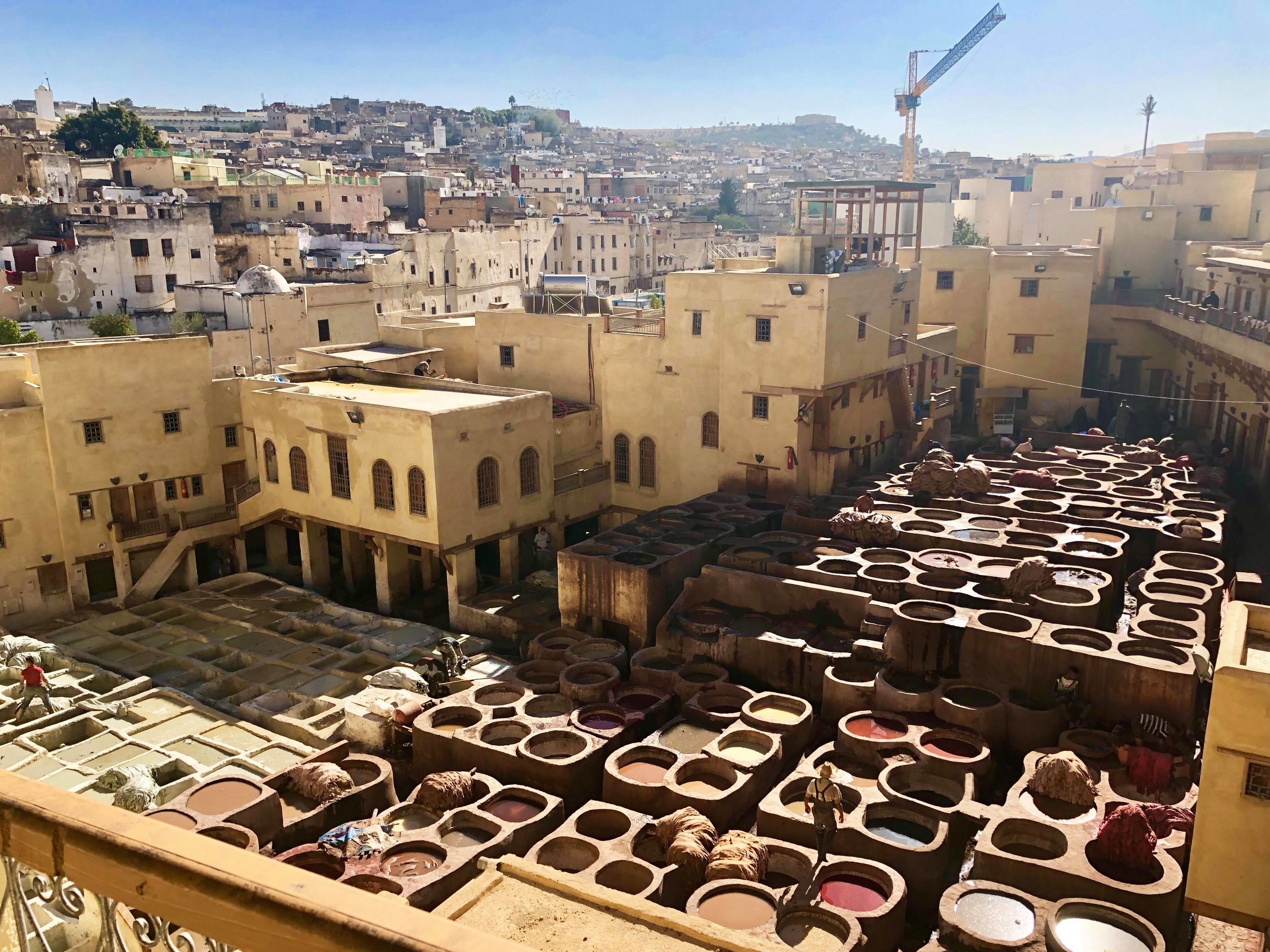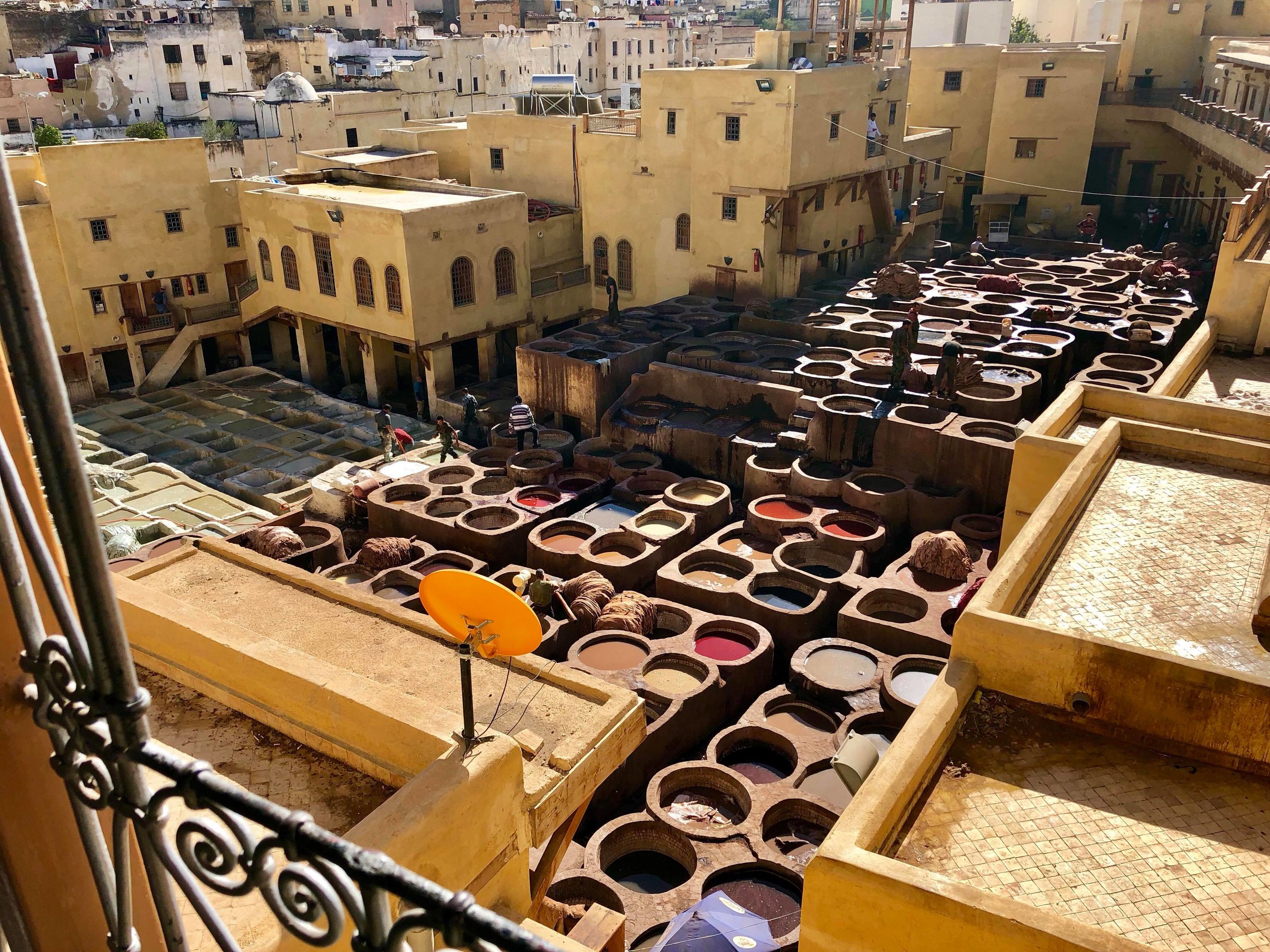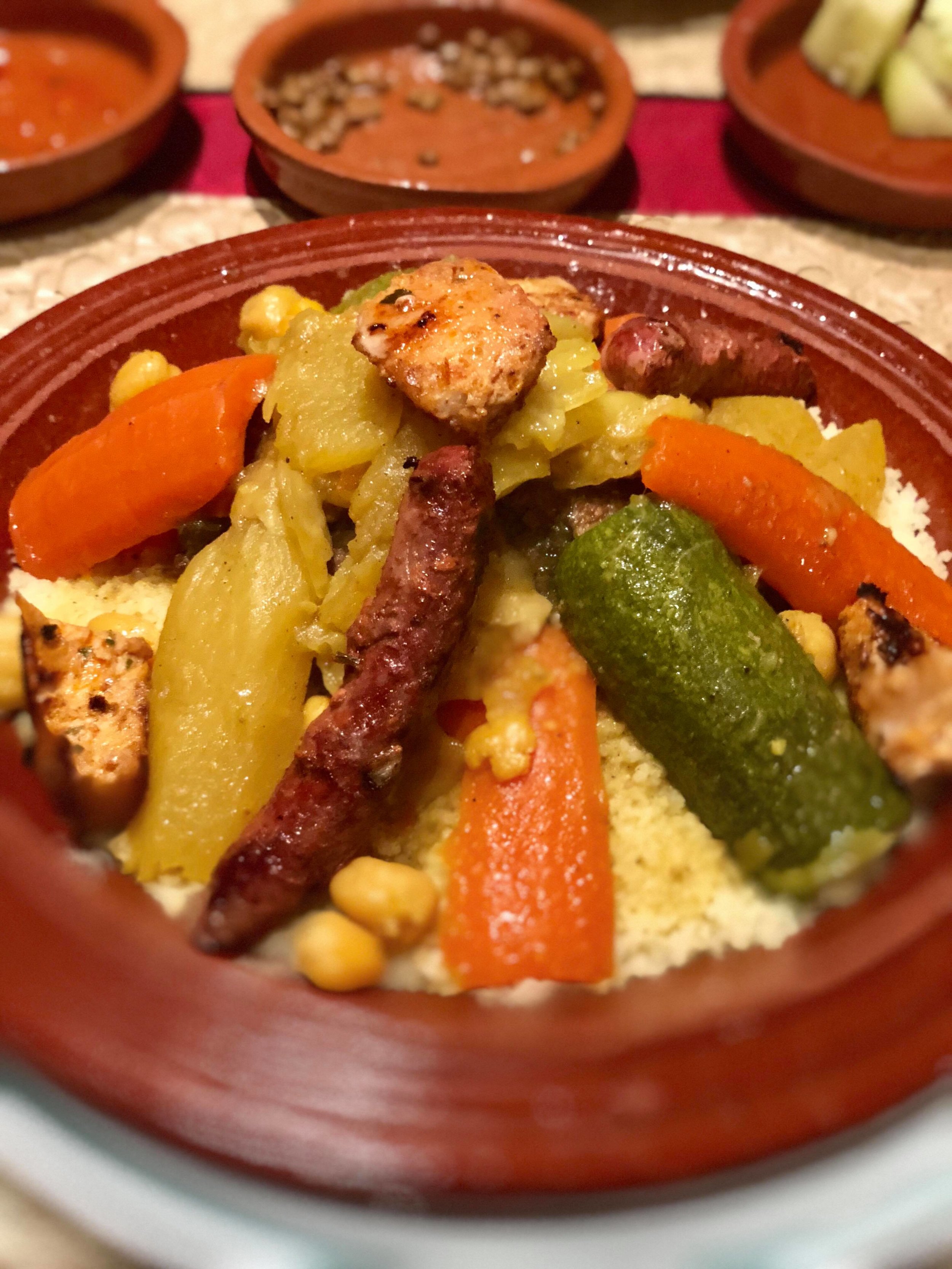Fez is known as one of the cultural capitals of Morocco. A frequented city by many visitors, my one day here was inundated with history. From the Jewish Quarter to the famed Fez Medina, the vibrant sights, colors, smells, and sounds of the city was incredibly novel and overwhelming at the same time. This was a place unlike anything I'd ever known, and I thoroughly enjoyed it.
Our arrival into this fabled city took place at night - just in time for dinner. We headed to a riad - a traditional Moroccan house or palace with an interior garden or courtyard, usually inhabited by the wealthy - for some food and a show.
Left, various small plates to start, everything from eggplant, to lentils, to diced tomatoes, pomegranate seeds, and marinated olives, with the ubiquitous 'khobz,' bread.
Right, a specialty of Fez - 'pastilla' - a flaky savory pastry stuffed with shredded chicken, eggs, onions, and other spices, topped with sliced almonds, cinnamon, and powdered sugar. Never having had such an eclectic mixture of ingredients in one dish - I found it to be somewhat on the sweet side, albeit interesting.
Left, another classic: stewed beef with dates, topped with sesame. Right - the Moroccan answer to post-dinner dessert - tangeries, apples, and bananas arranged in a fruit tower.
Below, a drumming performance at the riad. If you look closely at one of the men - he's using scissors and playing it a triangle.
Various performances were included with the show that came with dinner. Below, a belly dancer - the way she moves her hips - don't know how she does it!
The next morning, we begin our tour of Fez at the gates of the Royal Palace, also known as the Dar el Makhzen. Dating back to the 14th century, the palace is not open for tourism, but the plaza and its seven golden gates are available for public viewing.
Something I did not know prior to the trip: Morocco still exists today as a monarchy - which means its current King is the head of state, and has the legislative powers of a president or prime minister.
Totalitarian rule aside, during my brief time in the country, I found its infrastructure to be keenly developing and societal order well established.
A wondrously colorful corridor in the old Jewish Quarter.
Neatly uniformed policemen can be found frequently, small hotels, even in rural areas, were very clean, and tourist destinations were marked and regulated to protect visitors.
Something to note about the balconies seen below - notice how airtight the windows are covered, and the lack of access of the terraces to the outside streets.
Because of the conservatism of the Muslim faith and the tendency for females to stay inside the home, most balconies in the Muslim world open into internal courtyards, away from the prying eyes of strangers and the public streets.
Another narrow alleyway in which one cannot peer into the windows, and thus lives, and wives, of strangers.
Art Naji is popular among more artistically inclined tourists who wish to see the creation process behind Morocco's famed pottery and intricate mosaics.
Mosaic fountains, walls, tabletops, and colorful earthenware are central to Islamic architecture and interior design. It all starts here, where clay is mixed and formed into the required forms and left in the sun to dry.
The process continues for vases, plates, pots, and other wares, as artisans mold the clay in the shape they so desire.
Seen here, another artisan creating pieces of a mosaic.
In the store, vases and plates adorn every inch of the walls. Trays, bowls, cups, and even larger pieces of furtniture are available here, shippable via DHL to anywhere in the world.
Finally, we make our way to the bustling medina. The entrance beckons with promises of worldly trinkets, fresh produce, and so, so much more.
Once inside, the cacophony of sounds is immediately overwhelming. The initial sections of the medina are reserved for food. Everything from fresh produce to meat to various sundries under the sun.
In a similar theme, this follow series of corridors are shops of traditional clothing for men and women, as well as various local crafts.
A communal bakery typically shared by many families living in its vicinity. Usually the heat from the stove used to heat hammam baths above are also used to bake 'khobz,' the pita-like Moroccan bread that seems comparable a staple carb of the region.
This particular store sells various metal goods, copper plated lighting, and more.
Known as the 'quiet square' for the precise opposite, workers craft copper pots and pans of various shapes and sizes in the open space.
A brief interlude for lunch: chicken with caramelized onions and the ubiquitous Moroccan bread 'khobz,' freshly chopped tomatoes, onions, and parsley, along with a lentil soup / dip conconction.
A savory and sweet dish of grilled chicken topped with extra caramelized onions, and a plate of fresh olives. Its interesting to note how the cuisine of Morocco frequently features elements of sweet and salty in tandem (pastilla, various tagine dishes) - something usually found in distinctive dishes in many other parts of the world.
Back to the Fez Medina, every twist and turn is an unexpected visual adventure. Geometric walls and juxtaposing alleyways, sharp corners and ornate doorways, visual delights abound in these ancient marketplaces.
Complicated designs and patterns adorn many doorways along the paths of the medina. Many are entrances to 'riads,' or enclosed homes with courtyards and balconies opening onto the inside, for the sake of privacy of those residing within.
Thus, one never really knows whether they might be walking past a magnificent riad of the past, as busy locals and visitors alike jostle for the myriad of goods bought and sold here daily.
Though modern clothing can be seen on most of the youth and denizens of rural and urban areas alike, I was surprised to nonetheless find an abundance of people dressed in the traditional clothing of the region.
Not only a place of business and trade, the medina is also home to what the guide emphasized as the world's oldest university. Seen here, the entrance to this esteemed Koranic school.
The Al-Attarine Madrasa, built in 1323-5 by the Marinid sultan.
Today the madrasa is frequented by visitors for its intricate engravings and unique design.
Seen here, a view of the green rooftops from a window on the second floor of the school. Once upon a time, the second floor was used as student dormitories for those pursuing Koranic studies.
And finally, one of the more iconic images of Fez - the famed leather tannery. Seen here, huge caldrons of natural and synthetic dye, and sheaths of leather being manually processed through the colored vats.
Though the smell of dye and leather can be a potent combination, its fascinating to observe the workers move amongst the massive vats of dye, and the large piles of leather laid flat in the sun to dry.
The best vantage point to view the bustling activiti down below is from one of the leather shops that surround the tanneries. Here, all manner of leather goods are sold - from purses to jackets, cushion covers to belts.
Ironically, dinner tonight took place at a restaurant called 'Marrakech.' Food here, however, was delicious, and as usual consisted of tagine and couscous. Below left, the 'couscous royale' and the beef tagine.
I found the couscous in Morocco to be consistently very moist, and the various vegetables (frequently carrots, onions, zucchini, radishes) always very tender. Green pepper, olives, tomatoes came with the beef tagine - the ubiquitous tagine.




